The 7 Types Of Modern Warships Explained
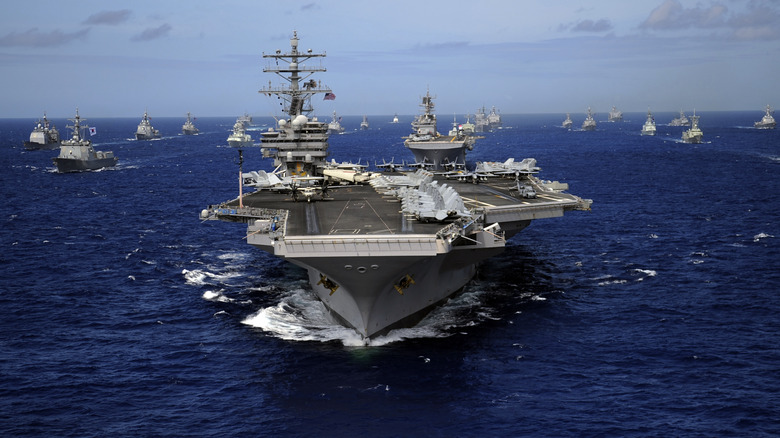
Naval warfare can be a captivating subject, evoking images of mighty vessels navigating vast oceans, locked in strategic battles, and defending the interests of nations. From legendary ships of the past to the sleek warships of today, the evolution of naval warfare is a testament to our pursuit of maritime exploration and supremacy. Modern navies have a wide variety of ships to fulfill different roles in today's ever-changing military landscape. Military ships can come in all shapes and sizes. Although different countries may have different names for them, all modern military ships typically fall within seven categories. These include Frigates, Corvettes, Destroyers, Cruisers, Submarines, Amphibious Warfare Ships, and Aircraft Carriers.
Each type of warship plays an important role in overall naval operations, allowing for versatility and effective missions. Some may never leave their home ports and spend their time patrolling nearby shores, some provide immediate humanitarian relief, while others have enough firepower to level a city. As we explore these different types of modern warships, we'll look at the historical significance of each, the technological advancements that each has undergone over the years, and the purpose it plays in the fleet.
These warships give us valuable insights into the pivotal role these vessels have played in shaping the balance of power on the global stage. Here we will delve into the depths of naval warfare and tell the stories behind the seven types of modern warships, their contributions, and their enduring impact on naval power.
Throughout naval history, the term "frigate" has been applied to various types of ships, encompassing a range of classifications. From traditional sailing vessels with masts to modern guided missile escorts, the concept of a frigate has evolved significantly over time. In the present era, frigates are larger than Corvettes or shore patrol boats but have less armament compared to Destroyers or Cruisers.
During World War II, frigates played a crucial role as an intermediary between Corvettes and Destroyers/Cruisers. Corvettes lacked the necessary resources to operate effectively in extended open-water missions. Frigates were designed to be faster than corvettes while also possessing sufficient armament for anti-submarine operations. Although they did not have the same firepower as Cruisers or Destroyers, their primary objective was to escort and engage vulnerable submarines that were forced to resurface.
The Oliver Hazard Perry-class warship served as the final active service frigate in the United States Navy (USN). However, all active duty ships of this class were decommissioned in 2015. This decision was prompted by the emergence of a new ship class, known as the Littoral Combat Ship (LCS), which assumed the previous roles of frigates. Presently, the USN is exploring a return to the frigate designation through a newly awarded design contract to Fincantieri. This upcoming frigate class is currently referred to as the Constellation class frigate and is expected to enter production and service in the coming years.
Corvettes are nimble and high-speed vessels frequently employed as coastal patrol boats. While the corvette designation may vary across countries, these ships are typically restricted to operating in close proximity to naval bases and are seldom deployed independently in open waters.
These vessels are renowned for their ability to swiftly respond to threats along a nation's coastlines, making them valuable assets for fast attack and response missions. A significant advantage of corvette-class ships lies in their compact size and exceptional speed. Due to their smaller dimensions, they do not necessitate specialized naval engineering docks like carriers or cruisers. Instead, smaller engineering bays can be utilized, facilitating easier mass production.
Although the United States Navy (USN) does not presently possess any ships specifically designated as corvettes, there are several smaller ship classes that fall within a similar category. Notably, the larger patrol boats operated by the U.S. Coast Guard exhibit characteristics and capabilities akin to corvettes, even if they lack the specific designation. Additionally, the LCS (Littoral Combat Ship) class of vessels served as a temporary replacement for frigates and corvettes.
LCS ships can be classified as corvette-style warships as well. Certain newer models of LCS ships were initially intended to succeed frigates, but following field testing, issues including exceeding budgetary limits and failing to deliver promised capabilities emerged. Consequently, the majority of LCS ships were decommissioned, and all future production of this class has been halted.
Destroyers played a significant role as fast attack ships during World War II, primarily serving as escort vessels attached to battle groups. With their ability to carry torpedoes and effectively hunt submarines, they were essential assets in naval warfare. However, the landscape of naval tactics and doctrines underwent a substantial transformation with the widespread adoption of modern guided missiles.
In the immediate post-World War II period, destroyers boasted greater speed than Cruisers, although they were comparatively less armored and equipped with less advanced onboard technology. They relied on escort ships for advanced logistics and tracking capabilities but compensated with enhanced firepower, torpedoes, and anti-submarine mines. Their specific missions during World War II necessitated specialized design and functionality. Destroyers were required to be swift to close in on enemy ships and deliver rapid strikes, resulting in thinner armor plating and a focus on ship-killing weaponry like torpedoes.
The advent of guided missiles has largely rendered armor obsolete, as modern missiles possess the capability to penetrate most conventional armor plating. Consequently, the need for heavily armored warships has diminished. This shift has enabled both destroyers and cruisers to be equipped with comparable equipment and armor, thereby aligning their operational capacities. Modern destroyers continue to fulfill a range of functions as escorts. However, many have evolved into mobile missile platforms, armed with guided missile launchpads. This transformation allows them to serve both offensive and defensive roles, significantly augmenting their capabilities in modern naval warfare.
Cruisers are renowned as some of the largest and most heavily armored surface attack ships in modern navies. Their size and armament surpass that of carriers, which primarily rely on aircraft for their weaponry. Following World War II, the line between cruisers and destroyers has blurred significantly. Traditionally, cruisers were characterized by their powerful armor and offensive capabilities. However, with the advent of guided missiles in warfare, heavily armored ships were rendered less relevant. Consequently, cruisers shifted their focus from armor to missile platforms and torpedo launchers. Although today's modern cruisers feature reduced armor, they remain highly lethal vessels. Many of these cruisers are equipped with vertical launch missile systems, a main gun, and various smaller gun placements.
Present-day cruisers serve vital offensive roles on the battlefield. In addition to their potent offensive capabilities, many modern cruisers have advanced electronic countermeasures and defensive systems, often functioning as ballistic missile defense platforms. Despite evolving over time, cruisers maintain their significance within naval fleets. They continue to be optimized for combat effectiveness and multi-role operations, serving as the backbone of numerous navies worldwide.
Submarines have undergone notable advancements since World War II, particularly with the integration of nuclear reactors. This revolutionary addition has addressed one of the primary drawbacks of submarines. Previously, diesel-powered submarines had to resurface periodically, rendering them vulnerable to enemy attacks. In contrast, modern nuclear-powered submarines have the capability to generate their own water and oxygen, enabling them to remain submerged for extended periods and operate independently.
Furthermore, the enhanced power supplied by nuclear reactors has facilitated the construction of larger submarines equipped with multiple missile racks. The pioneering efforts of Admiral Hyman George Rickover, overseeing the development of the world's first nuclear submarines, earned him the title of the "Father of the Nuclear Navy." Recognizing their combat potential, Rickover also predicted that submarines could eventually render other ship types obsolete, envisioning a future where all naval missions could be effectively handled by these underwater vessels.
Modern submarines serve a diverse range of roles, including counter surveillance, radar operations, escort duties, asset insertion, and functioning as mobile missile platforms. With their ability to submerge underwater and remain undetected for extended durations, they have become one of the most lethal and efficient warships on the seas today, second only to aircraft carriers. Their versatility and strategic advantages make them indispensable assets within any fleet.

Amphibious warfare ships
Contrary to the name, Amphibious warfare ships are not all designed to operate on dry land. Their primary purpose is to swiftly transport significant quantities of ground equipment, such as trucks, tanks, and troops, from ships to shore. Amphibious vehicles come in various sizes and configurations, especially the Wasp-class vessels. Although they may resemble carriers due to their impressive size, they are smaller and fulfill different operational roles.
The USS Makin Island and similar Amphibious warfare ships serve as transport and command vessels. During operations, they have the capacity to deliver approximately 1,800 fully equipped ground troops, along with vehicles and any other resources required to establish a base of operations anywhere in the world. The amphibious fleet of the U.S. Navy operates closely in conjunction with the Marines, with their primary objective being the rapid deployment of Marines to any theater of operations. Thanks to their global base coverage and the support of amphibious warships, Marines can establish a beachhead on any coast within a matter of days.
In addition to larger amphibious craft like the Wasp-class ships, there are several smaller landing craft that fall under the amphibious classification. These vessels can be driven onto shore to offload equipment and troops. Examples include the Amphibious Assault Vehicle (AAV), which resembles a tank and can operate on both land and water, and the Land Craft Utility vehicle (LCU), which can be beached and deploy ramps for the quick disembarkation of small vehicles and troops.
Aircraft carriers
The widespread adaptation of aircraft carriers since World War II has brought about a marked transformation in naval warfare. Alongside the introduction of guided missiles, carriers have rendered battleships completely obsolete, exerting dominance over modern navies ever since. Modern carriers are colossal vessels equipped with cutting-edge technology, resembling small floating cities with a crew capacity of approximately 5,000 personnel. Currently, the world's largest carrier is the newly commissioned Gerald R. Ford class, which replaced the long-standing Nimitz class.
The Gerald R. Ford class represents a pinnacle of Carrier engineering, incorporating advanced electronics and modern technology throughout its construction. Unlike its predecessor, the Nimitz, this class does not rely on outdated internal systems like steam lines. By leveraging these advancements, the carriers can achieve equivalent operational capabilities with approximately 500 fewer crew members.
Aircraft carriers today serve a diverse array of missions such as mobile attack and defense platforms, operating various wing groups. Their mobility also places carriers as rapid response forces, capable of swift deployment. Moreover, carriers are frequently called upon for diplomatic endeavors, as few assets demonstrate diplomacy more prominently than a multi-billion dollar floating weapon platform anchored off the coast of a foreign nation. Carriers also play a vital role in disaster relief and humanitarian missions. Their modern capabilities enable them to provide power to affected areas, provide food for thousands, and produce roughly 200,000 gallons of potable water daily. These capabilities make carriers invaluable assets in addressing crises and delivering aid on a global scale.

The global authority in superyachting
- NEWSLETTERS
- Yachts Home
- The Superyacht Directory
- Yacht Reports
- Brokerage News
- The largest yachts in the world
- The Register
- Yacht Advice
- Yacht Design
- 12m to 24m yachts
- Monaco Yacht Show
- Builder Directory
- Designer Directory
- Interior Design Directory
- Naval Architect Directory
- Yachts for sale home
- Motor yachts
- Sailing yachts
- Explorer yachts
- Classic yachts
- Sale Broker Directory
- Charter Home
- Yachts for Charter
- Charter Destinations
- Charter Broker Directory
- Destinations Home
- Mediterranean
- South Pacific
- Rest of the World
- Boat Life Home
- Owners' Experiences
- Interiors Suppliers
- Owners' Club
- Captains' Club
- BOAT Showcase
- Boat Presents
- Events Home
- World Superyacht Awards
- Superyacht Design Festival
- Design and Innovation Awards
- Young Designer of the Year Award
- Artistry and Craft Awards
- Explorer Yachts Summit
- Ocean Talks
- The Ocean Awards
- BOAT Connect
- Between the bays
- Golf Invitational
- Boat Pro Home
- Pricing Plan
- Superyacht Insight
- Product Features
- Premium Content
- Testimonials
- Global Order Book
- Tenders & Equipment
10 of the biggest superyacht conversions
Related articles, superyacht directory.
It's not easy to transform a vessel built for function into a thing of beauty. But, if done right, the results can be magnificent. From naval frigates to ice-breaking tugs, we take a look at the top ten largest superyacht conversions to date...
1. Yas | 141m
Yas was first delivered in 1978 as a naval frigate named HNLMS Piet Hein . After two decades of service in the Dutch Royal Navy and a decade serving the UAE military, she was released from duty and converted into a private yacht under the codename Swift 141. Jacques Pierrejean is the man behind her futuristic design which includes a giant glass dome. The entire project was carried out in Abu Dhabi and the vessel was extended by 12 metres to accommodate a new pool deck. In 2011, she was relaunched in Port Zayed in Abu Dhabi and is the 11th largest yacht in the world .
2. Maryah | 125m
The 125 metre former Russian research vessel sailed under the names Dalmorgeologiya , Fortune and Czar , before she was converted into a SOLAS-compliant superyacht by Greek shipyard Elefis in 2015. Details of her interiors have been closely guarded but are said to feature a cinema and accommodation for 54 guests across her six decks.
3. Alexander | 121.95m
Alexander first splashed in 1965 and served as a cruise liner until 1985 when, after several changes of ownership, she was converted into a superyacht by Greek shipping tycoon John Latsis. She was extensively refitted in 1985 and then again in 1998, with accommodation for up to 80 guests in 40 staterooms. Highlights include a swimming pool, hospital, gymnasium, a 27-seat cinema and a helicopter landing pad.
4. Project Y910 | 120m
Built in Poland in 1990, the 90 metre vessel served as an offshore supply ship named after the Russian writer Vladimir Chivilikhin . The ship was in service until 1998 when its owner decided to convert the vessel into a luxury per-cabin charter yacht under the project name KAY. Work on the hull began at Keppel Singmarine before the yacht made its way to Italy for outfitting at Fincantieri. The half-built project was put up for auction in November 2021. Currently lying at the Fincantieri shipyard in Trieste, she patiently awaits a new owner.
5. Turama | 116.41 m
Christened Delfin Caravelle, the 116 metre vessel was delivered as a passenger ship in 1990 by Finnish shipyard Rauma and converted into a luxury charter yacht in 2004. Little is known about the conversion of Turama .
6. Dream | 106.5m
The 106.5 metre Dream was born into the world as a humble passenger vessel before she embarked on a near decade-long conversion project to fulfil the lifelong dream of an ambitious new owner. Under the project name Poseidonos, work began in 2008 at Chalkis Shipyards in Greece with exterior design by Studio Vafiadis and an all-new interior by Ciarmoli Queda Studio. The team's efforts were rewarded when Dream picked up a Neptune for Best Converted Yacht at the 2019 World Superyacht Awards .
7. Christina O | 99.15m
Christina O was built for the Canadian Navy as an anti-submarine frigate under the name HMCS Stormont . After surviving in the second world war, she was purchased for scrap value by Greek shipping magnate Aristotle Onassis, who then converted her into the legendary Christina O . A six-year conversion ensued and she was reborn in 1954 as an ultra-luxury private yacht that was regularly seen to host royalty and the Hollywood A-list with the likes of Greta Garbo, Marilyn Monroe, Frank Sinatra, Sir Winston Churchill, Grace Kelly, John F Kennedy and Elizabeth Taylor welcomed on board.
8. Voyager | 91.4m
Previously known as Danah Voyager , the conversion of this former offshore supply ship is the largest to take place on American soil. First delivered by Swiftships in 1997, the 63 metre commercial vessel arrived in Dania Cut in Florida in 2016 and emerged from the sheds three years later as a 90 metre explorer with five decks, 70 crew and a dive centre.
9. Dubawi | 90.6m
Dubawi began life in 1989 as a small passenger ship built by Cantieri Navale Ferrari before she was converted into a private yacht two decades after her launch. The project was awarded to Dubai shipyard Platinum Yachts and remains one of its biggest projects to date, second only to the 162 metre Dubai . Work included a five-metre extension, a restructuring of the top deck and an entirely new interior.
10. Lauren L | 90m
Built by Cassens-Werft in 2002, Lauren L began life as a cruise ship sailing under the name Constellation . After four years in service, she was bought by Liveas Yachts who converted her into a modern charter yacht with the capacity to carry a maximum of 40 guests.
More about this yacht
Yachts for charter, more stories, most popular, from our partners, sponsored listings.

The most comprehensive and authoritative history site on the Internet.
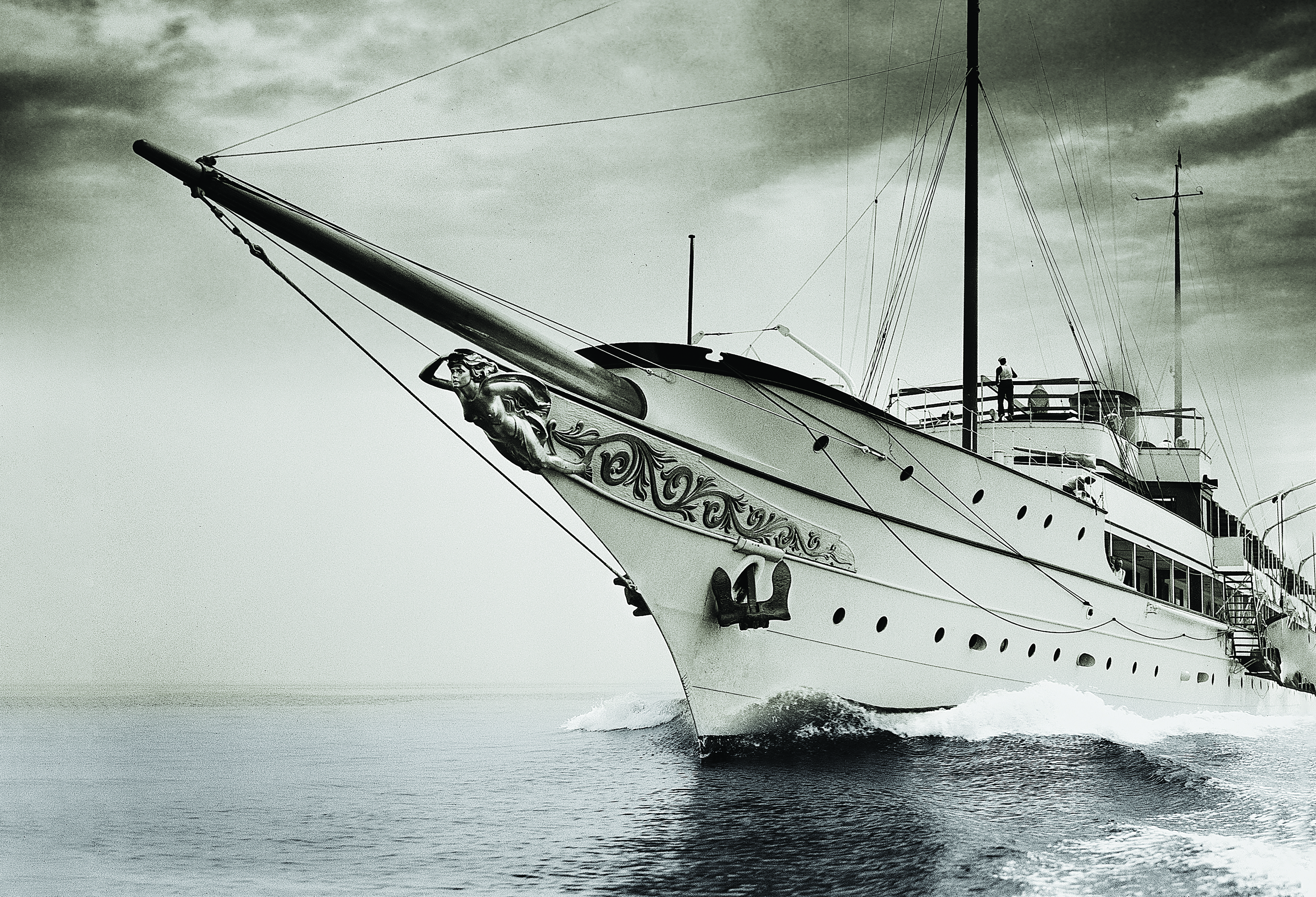
Commandeered by the Navy, Plutocrat’s Maritime Plaything Went Down a Gallant Warship
Adorned with teak and a gilded bowsprit, ss hi-esmaro was rechristened uss niagara and went to fight the japanese.
Ravaged by aerial attack, the auxiliary tender, heavily burdened with a load of ammunition, depth charges, and aviation fuel, was wallowing in open water between the Solomon Islands and New Guinea on Friday, May 22, 1943. The vessel’s 136-man crew had abandoned ship. A tin fish deliberately loosed by a friendly boat set off explosions that blew the tender to pieces. The pieces sank in the South Pacific. The ship that vanished and its mercy killer both belonged to the U.S. Navy. However, while the attacking craft, though wooden-hulled, was strictly military—a Patrol Torpedo (PT) boat—the vessel destroyed was made of steel and had had a complicated career. Originally an industrialist’s yacht more accustomed to hosting big shots than serving swabbies, USS Niagara had been commissioned for the duration. Now its war was over.
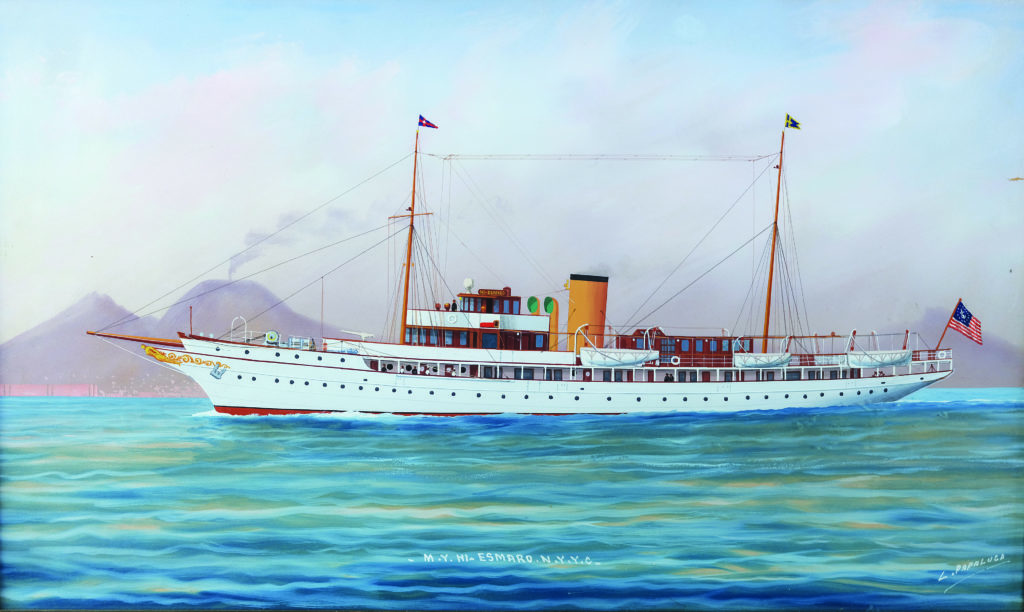
Work on the pleasure craft destined for combat began in July 1928, when American asbestos magnate Hiram Manville, proprietor of the Johns-Manville Company, put a down payment on a diesel yacht at Bath Iron Works in Bath, Maine. By June 1929, when, with most of Bath’s population watching, the 267’, 1,333-ton white-hulled vessel slid from a shipyard cradle into the Kennebec River estuary, change orders had run the original $769,827 price beyond $900,000—today, in excess of $12.6 million. The first syllables of the names of father Hiram, daughter Estelle, mother Romaine, and Manville comprised their ship’s appellation— Hi-Esmaro , the same tag the family bestowed on its 150-acre estate at Pleasantville, New York.
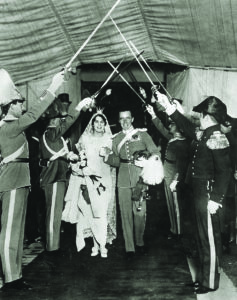
Romaine Manville christened the yacht, built for pleasure and to display status. On the boat deck beneath the bridge and chart room, the forward deck house featured a sunroom from which occupants had an unobstructed view of what lay ahead. Aft of the sunroom were the captain’s stateroom, equipped with a bath and a large wardrobe, and the wireless room. The owner’s suite, also on the boat deck, comprised a beautifully furnished double stateroom with sitting room and bath. Four other double guest staterooms each had private baths. Hi-Esmaro also had two bachelor rooms, plus accommodations for maids and valets. The main deckhouse incorporated a sedate but attractively decorated main salon and dining room paneled in solid teak. Estelle Manville, 24, had married into the Swedish royal family in 1928; replicas of that nation’s crown hung over the stateroom beds. Designed by yacht architect Henry J. Gielow, Hi-Esmaro had two Bessemer diesel engines and a sister ship, Vanda , built simultaneously for a Boston investor. A crew of 50 to 60, sometimes including a surgeon and a barber, staffed each vessel.
F or ten years the Manvilles, members of the New York Yacht Club, made abundant use of Hi-Esmaro , often to travel to sailing and crew races up and down the Eastern Seaboard.
One popular entry on the yachting calendar was an annual Harvard-Yale rowing competition along Connecticut’s Thames River. The finish line was a bridge inland from Long Island Sound linking riverside towns Groton and New London, Connecticut. On June 19, 1931, Groton-born canoeist Louis Grimmer, 12, got an eyeful of the Manville yacht. He particularly admired that rakish clipper bow and the mermaid bowsprit.
Louis had been paddling with friends through the spectator fleet anchored at the finish line when guests aboard Hi-Esmaro called down to the boys, “Good morning—who is going to win?”
Harvard did, finishing the four-mile downstream course in 21:29, 13 seconds ahead of Yale. Louis Grimmer never forgot his glimpse of Hi-Esmaro. “I used to dream at night of how I would like to own a yacht, such as this, and travel the world,” he recalled later.
The Manville yacht twice crossed the Atlantic to Europe, where Hiram and Romaine visited with Estelle and her husband, Count Folke Bernadotte. Once, the Swedish royal family joined the Manvilles for a Mediterranean cruise. In spring 1939, when Crown Prince Gustav Adolph and Crown Princess Louise visited New York to open Sweden’s exhibit at the World’s Fair, Manville put the royal couple up aboard the yacht. That September, Germany invaded Poland and the Atlantic became a combat zone.
After growing massively during the Great War, the American military had shrunk, especially the Navy, tightly hemmed by arms-control treaties until resurgent international tension reversed that. In 1938, authorized U.S. Navy tonnage began to rise. By 1940 the Navy had some 2,000 ships and was eager to acquire anything afloat serviceable enough to commission for coastal patrol and similar duties. That October the government bought Hi-Esmaro from Romaine Manville for $150,000; eventually more than half of the 500-odd vessels owned by New York Yacht Club members entered active service. Work began immediately to convert Hi-Esmaro into a warship at the Brooklyn Navy Yard.
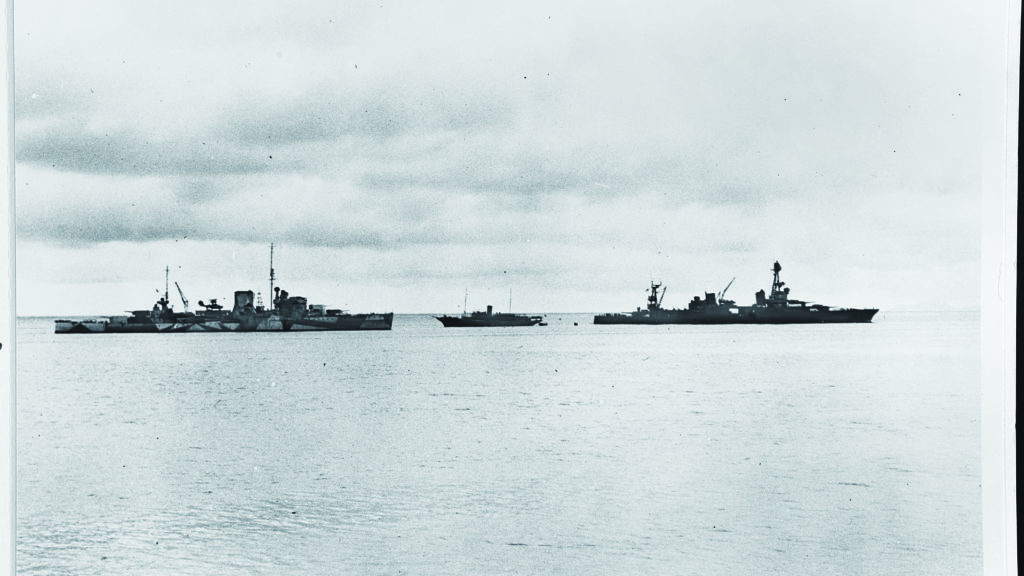
Connecticut canoeing enthusiast Lou Grimmer had joined the Navy. When his destroyer finished a cruise by docking in New York, he got orders to join the crew of a gunboat, USS Niagara (PG-52), as a storekeeper. “I will never forget the thrill I received when I walked down to the dock and found it was the old Hi-Esmaro, ” Grimmer said later. It grieved him to watch shipyard workers transmogrifying the yacht for battle, a process that sacrificed not only most of the deluxe interior but also those beautiful lines. Assigned with other sailors to shovel clear the snowbound pier at which Niagara was berthed, Grimmer and mates reached the bow as “the workmen were in the process of removing a bosomly mermaid whom we were all attached to and we pelted them with snowballs, as if we could stop them from their assigned duties.” The yacht-turned-auxiliary-gunboat now was armed with two .50-cal. machine guns as well as two 3-inch guns. The crew totaled 136. The Navy assigned Lou Grimmer elsewhere.
Commissioned at New York in January 1941, Niagara was ordered south. At Miami and Key West, Florida, and at Guantanamo, Cuba, Navy men who were training to go to war in PT boats lived aboard the former yacht. Returning to New York for repairs, Niagara relocated to Newport, Rhode Island, to resume its dormitory role at the Naval Torpedo Station. In August 1941, assigned to the Pacific theater, Niagara departed for Pearl Harbor, Hawaii. Anchoring there October 9, the vessel patrolled the islands until November 29, when Niagara joined a convoy escorting transports and heavy cruiser USS Northampton to Cavite, Philippines, by way of Fiji.
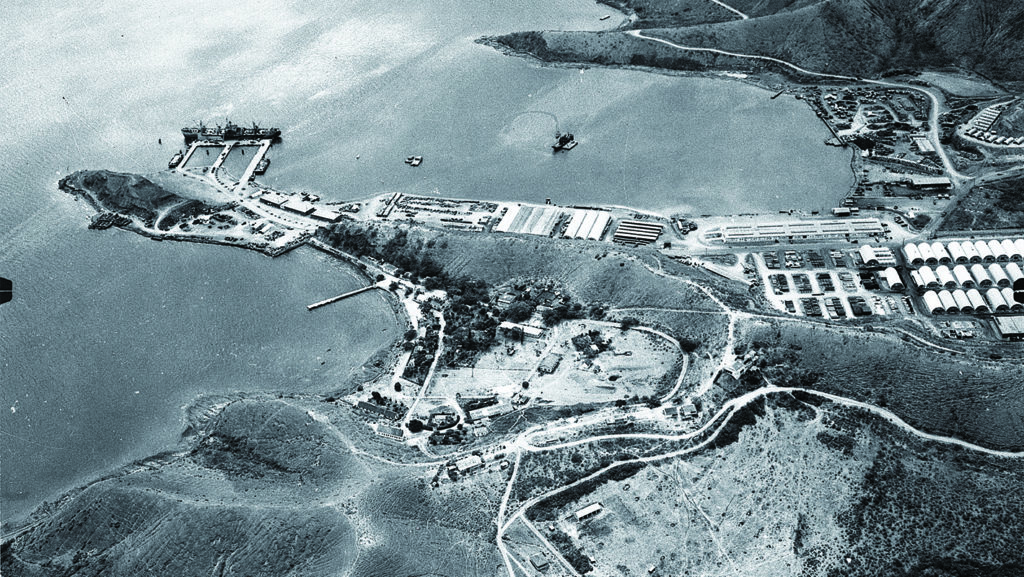
At sea when the Japanese attacked Pearl Harbor, Niagara , unable to keep pace with genuine combat vessels, was ordered to Pearl to assume such supporting duties as convoy escort and service as a tender to PT squadrons. In April 1942 the gunboat sailed east to guard approaches to the Panama Canal.
Overhauled that summer at New York, Niagara returned to Newport as a school ship. However, with the war in the South Pacific gaining scope and intensity, the Navy in that theater, now thick with PT boat squadrons requiring regular refueling, needed tenders—floating resupply vessels stocking fuel and armaments and providing repair services. Shipfitters equipped Niagara with reserve fuel tanks capable of holding 50,000 gallons. In late November 1942, Niagara sailed west via the Panama Canal and the Society Islands, en route officially designated the Navy’s first Motor Torpedo Boat Tender, Auxiliary Gun, Patrol (AGP-1). The crew anchored at Noumea, New Caledonia, on January 17, 1943.
The colonial capital of French New Caledonia, Noumea offered whoever controlled its harbor domination of the Coral Sea and southern Solomon Islands. The sheltered anchorage, now a vital Allied forward naval and air base, was home to an immense armada. The streets of the port were crowded with aviators, sailors, and Marines attached to battleships, aircraft carriers, cruisers, destroyers, repair ships, and smaller vessels.
One transient resident of Noumea was Frederick Ludwig, MD. The Michigan native, a Navy reservist, had left his medical practice in Port Huron to go on active duty. After a hurried two-week indoctrination at Great Lakes Training Center, Dr. Ludwig had sailed by Liberty ship out of San Francisco, debarking at Noumea in November 1942.
He thought it prudent to observe protocol by reporting for duty to his commanding officer clad as the Navy handbook prescribed. Pulling a rumpled, mildewed formal uniform from his seabag, Ludwig, 32, donned his heavy wool dress blues and in tropical heat sweatily quickstepped to headquarters, where a yeoman led him to a darkened room. As Ludwig was entering, a voice boomed, “Come in!” Proffering his orders with a salute to the silhouette in the shadows, the young doctor said, “Lieutenant Fred Ludwig reporting for duty, sir.”
The backlit officer stood.
“My God man, take off those blues!” he barked. “We only wear fatigues out here and never with a tie.”
There was another officer present.
“Are you the Dr. Ludwig just assigned to my hospital?” Captain Fred Conklin asked.
“Yes, sir,” Ludwig answered.
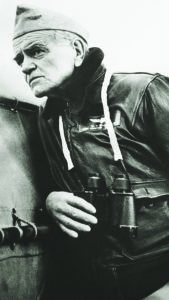
Conklin introduced Fred Ludwig to his host, Vice Admiral William F. “Bull” Halsey, commander of the South Pacific Theater of Operations. “We’re out here to fight a war,” Halsey said, now speaking in a warm voice. “Getting dressed up in coats and ties is a total waste of time.”
From Noumea, Halsey and subordinates were directing the American offensive in the Solomons, sometimes losing badly to Japan’s powerful fleet. Combat in the central Solomons was intense. At the Noumea hospital, Dr. Ludwig saw most of the casualties from those clashes. A case of the mosquito-borne tropical disease malaria made a patient of U.S. Marine Corps fighter ace and future South Dakota Governor Joe Foss. In 1943, Dr. Ludwig was ordered to assume the duties of medical officer aboard AGP-1, bound for the central Solomons. He busied himself stocking surgical instruments and supplies and familiarizing himself with running a commissary. To improve ventilation in the crew quarters, Ludwig oversaw the installation of screened doors, as well as wire mesh over the portholes. The Navy had not obliterated every trace of Hi-Esmaro ’s former life. The officers’ mess was paneled in teak, “with linen and silver services that had belonged to Manville,” Ludwig said. “It was the only tender where the master could push a button and the entire bulkhead would fold back and expose an extra bed.” On January 27, 1943, Niagara departed Noumea with Motor Torpedo Boat Division 23, Squadron 8. After stops at Efate and Espiritu Santo, the gunboat took up station at Tulagi on February 17.
Tiny Tulagi, off the larger island of Florida, was chief port and administrative center of the British Solomon Islands Protectorate, and one of the 900-mile chain’s best anchorages. At the start of the war in the Pacific, Tulagi’s coconut planters, traders, missionaries, and government officials had been in the path of Japanese forces sweeping south. A small garrison of Australian infantrymen guarded the civilians and a squadron of amphibious patrol planes and assisted what historian Samuel Eliot Morrison called a “Gilbert and Sullivan army of 15 whites, 5 Chinese and 130 native police in defending their base.”
In May 1942, t he Australians evacuated Tulagi; Japanese forces took over. An Allied victory that same month in the Battle of the Coral Sea stopped the Japanese advance.
By the time that Niagara reached Tulagi, the island had been recaptured and repurposed into a PT base. AGP-1 and the PT boats the former yacht supported operated at Tulagi in relative safety, though the small fleet’s anchorage was within range of shore-based aircraft using a major Japanese bastion 650 miles northwest at Rabaul, on New Georgia, and other enemy-held islands north and west.
For concealment, AGP-1’s crew moored north of the Florida Island harbor, tying up to tree trunks against the Maliali River’s high, jungle-rimmed banks. The crew settled into the cycle of tendering: making repairs, restocking torpedo boats with water, fuel, ammunition, and weapons, meanwhile providing communication services for PTs sortieing from Tulagi on nightly security patrols around Guadalcanal.
Only 10° south of the equator, Tulagi was plagued by flies, mosquitos, and a fug of humidity and stale air thickened by daily afternoon rains. Besides doctoring common but vexing tropical maladies—dysentery, ear infections, ringworm, fungus—Lieutenant Ludwig treated combat casualties.
At midmorning on Wednesday, April 7, 1943, coast watchers reported an ominous bustle at Japanese airfields on Bougainville, 380 miles northwest: many planes taking on fuel and bombs. About noon, a message confirmed that a huge Japanese air fleet was bearing down on the Guadalcanal-Tulagi area. Fighter pilots scrambled from Henderson Field on Guadalcanal to intercept more than 170 Japanese attackers. Every ship and shore battery on Florida, Guadalcanal, and Tulagi joined in the defense. Japanese bombs sank oilers USS Kanawah and USS Aaron Ward and Royal New Zealand corvette Moa and did damage to British-built four-masted schooner USS Erskine Phelps , the oldest ship on active sea duty in the U.S. Navy. When nine two-man Aichi “Val” dive bombers swept up the Maliali at tree-top level, machine gunners aboard Niagara and minesweeper USS Rail , moored outboard of the tender, opened fire. The lead Val, damaged and flaming, crashed and exploded in mangroves 1,000 yards aft of Niagara . Two Vals got through, but the fourth was hit. Trailing white smoke, the Val crashed behind hills to the north. The last of the raiders made strafing runs, but in passing through heavy fire from Niagara they too were shot up and crashed in the jungle.
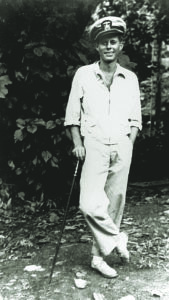
After the attack, Dr. Ludwig treated wounded men, mainly for burns, shrapnel injuries, and stress. Niagara resumed its routine. Repair work continued at a floating drydock. At the Tulagi government wharf, supplies and replacements occasionally arrived. Waiting to take command of a PT boat, newly arrived Lieutenant (jg) John F. Kennedy briefly bunked aboard Niagara .
In May 1943, as Halsey’s South Pacific naval forces were continuing their slow progress north and west, AGP-1’s captain, Lieutenant Commander David B. Coleman, got orders to establish a base on Woodlark Island, 500 miles due west of Tulagi and 150 miles from the immense island of New Guinea. At a British agricultural station on Malaita Island, Ludwig reprovisioned, loading up on fresh tomatoes, lettuce, and beans.
The crew topped off Niagara ’s hold and tanks. Early on the morning of Friday, May 22, 1943, Tulagi harbor’s anti-submarine nets opened and AGP-1, laden with 50,000 gallons of aviation fuel plus stocks of torpedoes and depth charges, passed into the sea, escorted by six PTs and bound for Woodlark Island.
By midday, Niagara had swung south of Guadalcanal and was sailing west. Dr. Ludwig was in the galley anticipating a salad from the Malaita gardens to accompany the noon meal.
Crewman Joseph Tropea, topside on watch, noticed a silhouette against the sun: a Mitsubishi 97 heavy bomber.
Tropea alerted the bridge. In a twitch, all hands were racing for their assigned stations to a chorus of “GENERAL QUARTERS…GENERAL QUARTERS…MAN YOUR BATTLE STATIONS.” As the Mitsubishi was closing, Captain Coleman ordered a tight turn to starboard at flank speed. As the 97 was releasing four bombs, Coleman ordered a swing hard to port. Three bombs struck water to starboard, the last near enough to disable the tender’s steering and dislodge the 3-inch gun. “We could not train it, but we could elevate it,” Tropea said. “So we kept firing to keep him from coming down on us.”
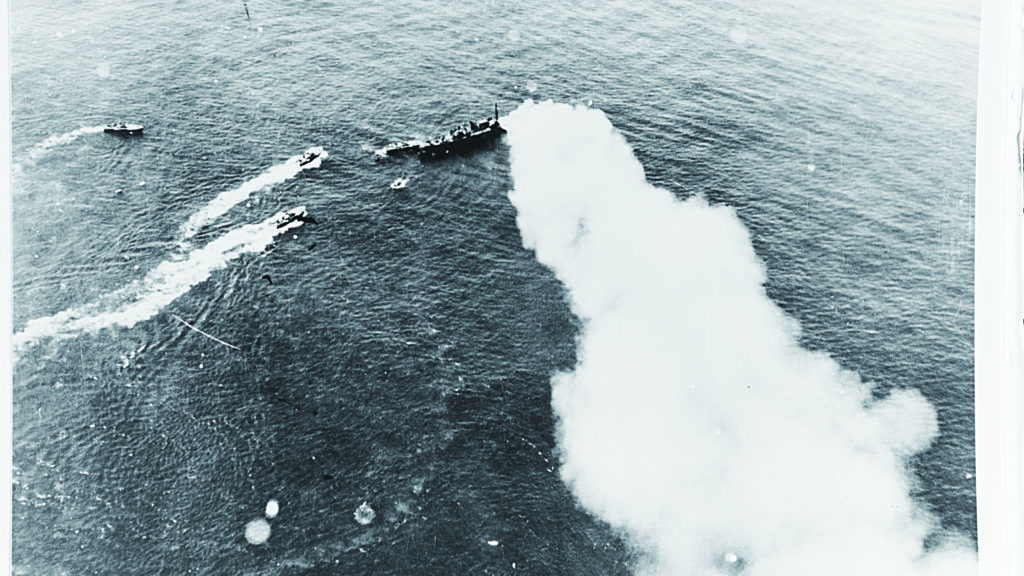
The bomber broke off. The crew got the steering working. In less than an hour the same 97 returned, accompanied by five other warplanes. One bomb in a pattern of more than a dozen hit Niagara ’s forecastle. Concussions from near misses caused more damage, including a 14-inch hole six feet below the tender’s waterline. Seawater began flooding two storerooms and a passageway. The power failed. Dead in the water and listing dangerously to port, Niagara had no recourse against attack. Engine room gangs were able to get one of the two main diesels going. Fires were burning below decks forward. Coleman, knowing the result if his stores went up, gave the order to abandon ship.
Tropea was about to leave when he saw flames in an officers’ quarters near an ammunition locker. He and a shipmate brought an extinguisher to bear. When the men ran low on flame retardant, Tropea dashed topside for another extinguisher. A bomb blast knocked him down a gangway, injuring one of his knees. He and the other man kept up their firefighting until an officer ordered them over the side. Most of the crew had already abandoned Niagara for lifeboats or PTs. Tropea, later awarded a Silver Star for valor, wrote, “I had a profound affection for that ship and I would have done anything to prevent it from going down.”
In the engine room, over the sound of bombs and 20mm fire, Seamen Tommy Knight and Cotton Wheeler got an urgent summons. “KNIGHT AND WHEELER, SECURE THE ENGINE ROOM!” the public address system blared. “IF THERE ARE ANY OTHER VOLUNTEERS, LEND KNIGHT AND WHEELER A HAND BEFORE YOU ABANDON SHIP!”
PT-110 commander Lieutenant Patrick Munroe recalled “the Japanese pilots giving us a jubilant wave before they left.” PTs 146 and 147 knifed toward the tender, closing in at either side of the stern to take off men still aboard. The tender was in grievous shape—generators out, pipelines severed, pumps smashed. The foredeck was in flames, bow to bridge.
Captain Coleman ordered a coup de grace by PT-147. The torpedo struck amidships, sending gasoline flames 100 yards high. Black smoke momentarily obscured the vessel, which buckled, bow and stern folding together before sinking beneath a billow of white smoke. Below the surface a lone depth charge detonated with a muffled boom.
Not one of Niagara ’s 136 men had been killed or seriously wounded in the action. Rescue vessels landed them at Tulagi early the next morning. U.S. Navy records show that 14 years after being christened as the luxury yacht Hi-Esmaro the USS Niagara received a battle star for World War II service.
Related stories

Portfolio: Images of War as Landscape
Whether they produced battlefield images of the dead or daguerreotype portraits of common soldiers, […]

Jerrie Mock: Record-Breaking American Female Pilot
In 1964 an Ohio woman took up the challenge that had led to Amelia Earhart’s disappearance.

Seminoles Taught American Soldiers a Thing or Two About Guerrilla Warfare
During the 1835–42 Second Seminole War and as Army scouts out West, these warriors from the South proved formidable.

During the War Years, Posters From the American Homefront Told You What to Do — And What Not to Do
If you needed some motivation during the war years, there was probably a poster for that.
Privacy notice
The Mariners' Museum and Park
The Mariners’ Museum and Park Logo
Site Search
Popular searches.
- Chris-Craft
- USS Monitor
Popular pages
- Plan Your Visit
- Events & Exhibits
- Student Programs
- Volunteers & Interns
- USS Monitor Center
The Legacy of USS Mayflower: Private and Presidential Yacht, US Navy Warship, Merchant Ship
Published July 2, 2021
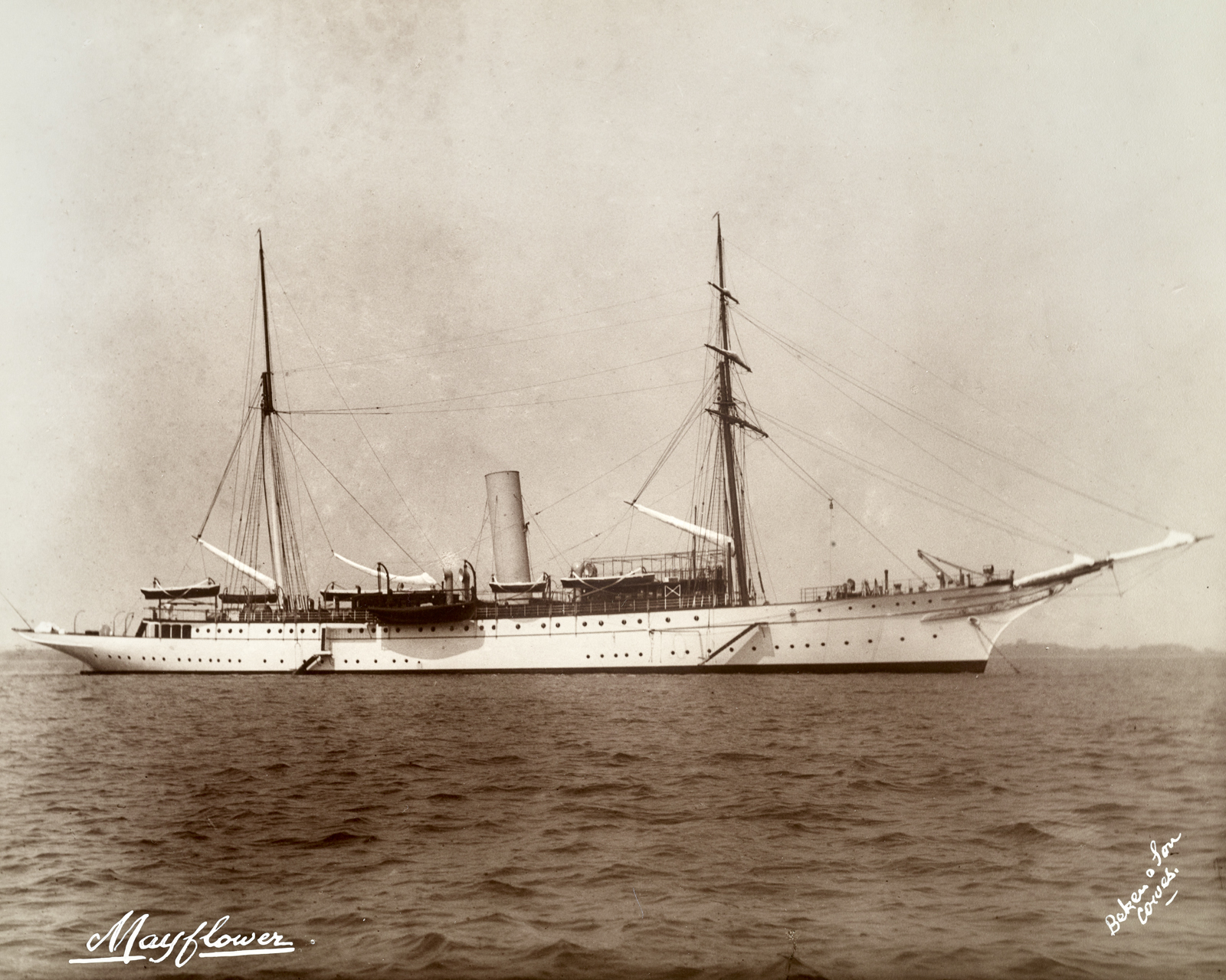
Several years ago, I first learned of USS Mayflower , a presidential yacht. I was studying about the 1905 Portsmouth Peace Conference at the Portsmouth Navy Yard in Kittery, Maine. I was curious but didn’t have time to delve into the ship’s history.
Since then, I keep “bumping into” stories about this ship as I study and learn more about other topics. I read Erik Larson’s Dead Wake about the sinking of Lusitania and then read more about Woodrow Wilson’s relationship with Edith Bolling Galt. Turns out, they spent much of their time getting to know one another while on board USS Mayflower .
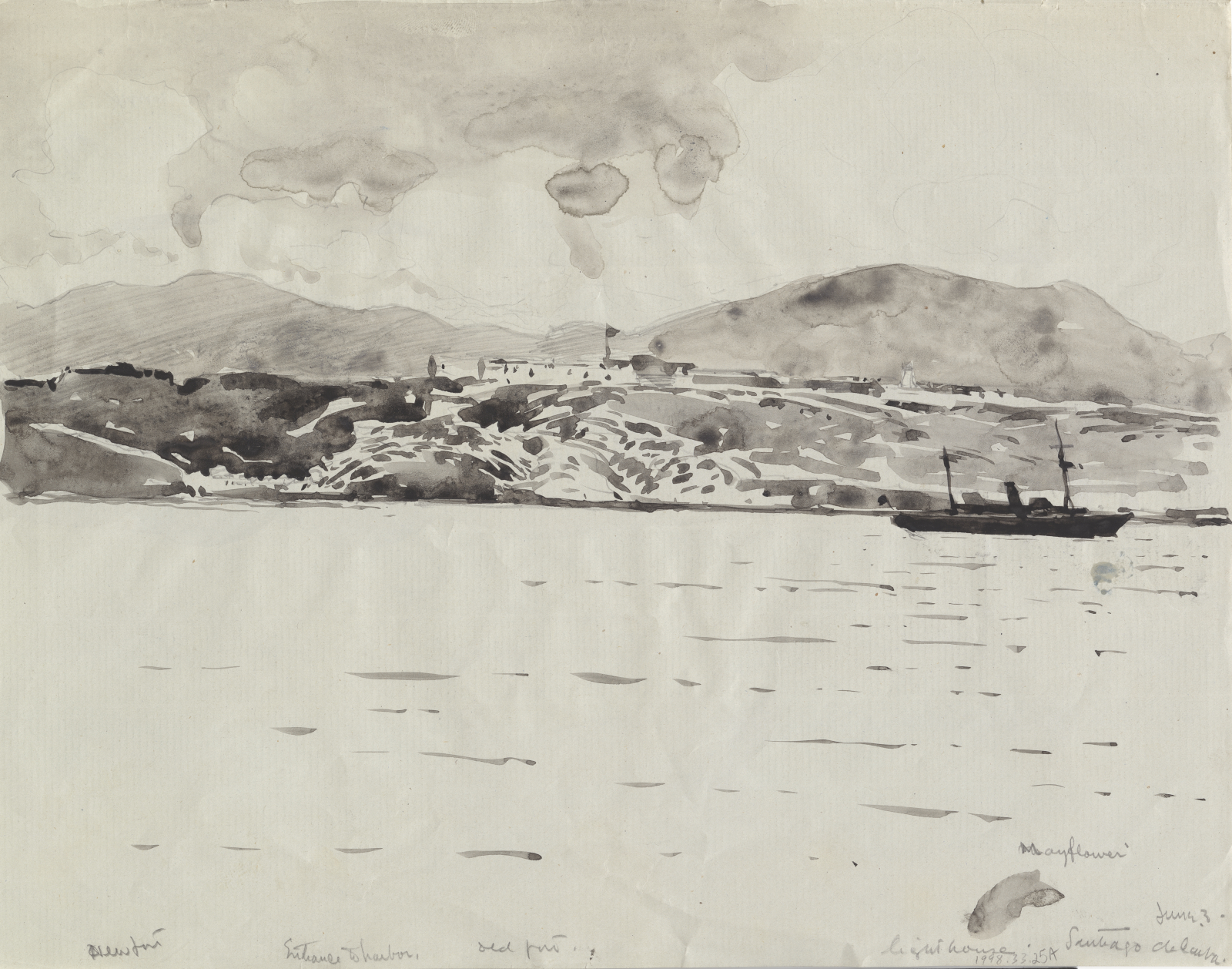
Due to the pandemic last year, most of the Mariners’ team worked remotely from home. My projects included cataloging works on paper — mostly plates removed from books, but there were also paintings. One collection was by the artist Carlton Chapman, a correspondent for Harper’s Weekly magazine during the Spanish-American War in 1898. I seriously appreciate his work because he labeled the artwork with the names of the locations and the ships in each scene! He is a hero of a museum cataloger’s heart.
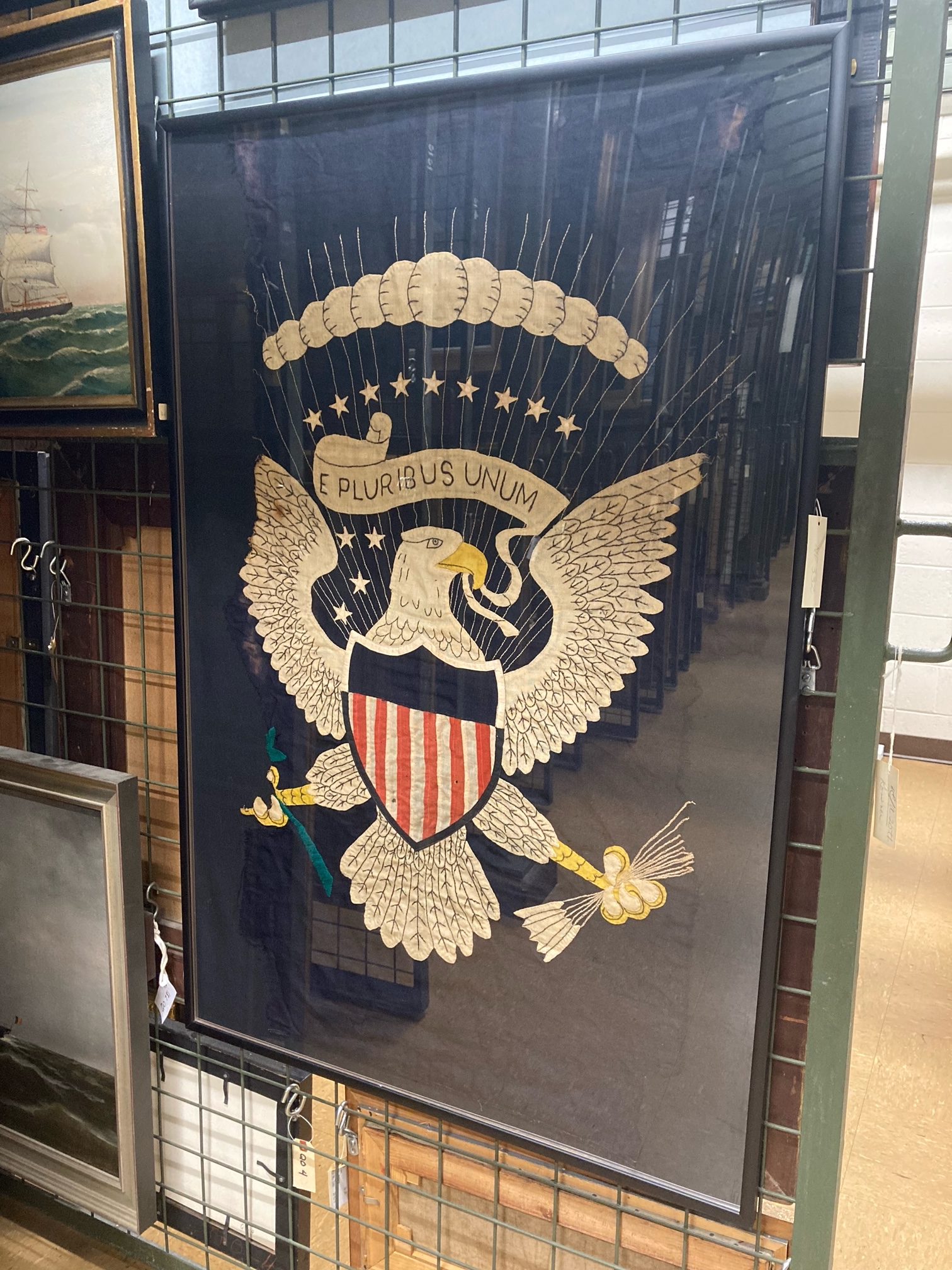
A few days ago, I was in collections storage with guests when they asked about a framed flag hanging on a rack. I looked up the accession number, and sure enough, it’s from USS Mayflower . Well, alright already, I’ll write a blog about it! And here we are.
The Early Years
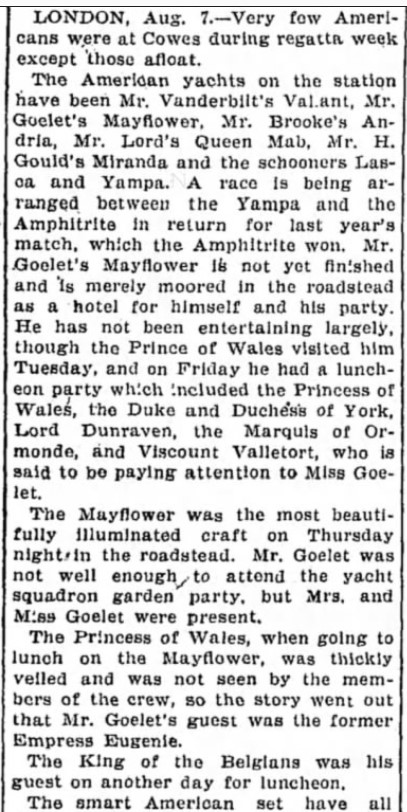
Sadly, Goelet did not get to enjoy his new yacht for very long. He passed away on board the yacht just a few weeks later, on August 27, 1897. He had been sick for an extended time, and The Daily Republican reported, “It is believed that the strain which Mr. Goelet underwent while entertaining guests at Cowes during the recent yachting events contributed considerably towards his death.” They must have been quite some parties!
The interior of Mayflower was, in a word, extravagant. “It is furnished more like a Fifth avenue mansion that [sic] a ship’s cabin, containing as it does a piano, settees, lounges, writing tables, etc. The work is executed in oak, carved and painted white in Louis XVI style. Adjoining this apartment is a stairway which leads to six commodious staterooms for guests. Next to these is the library, finished in oak in Louis XV style and containing 2,000 volumes.”
War and Peace
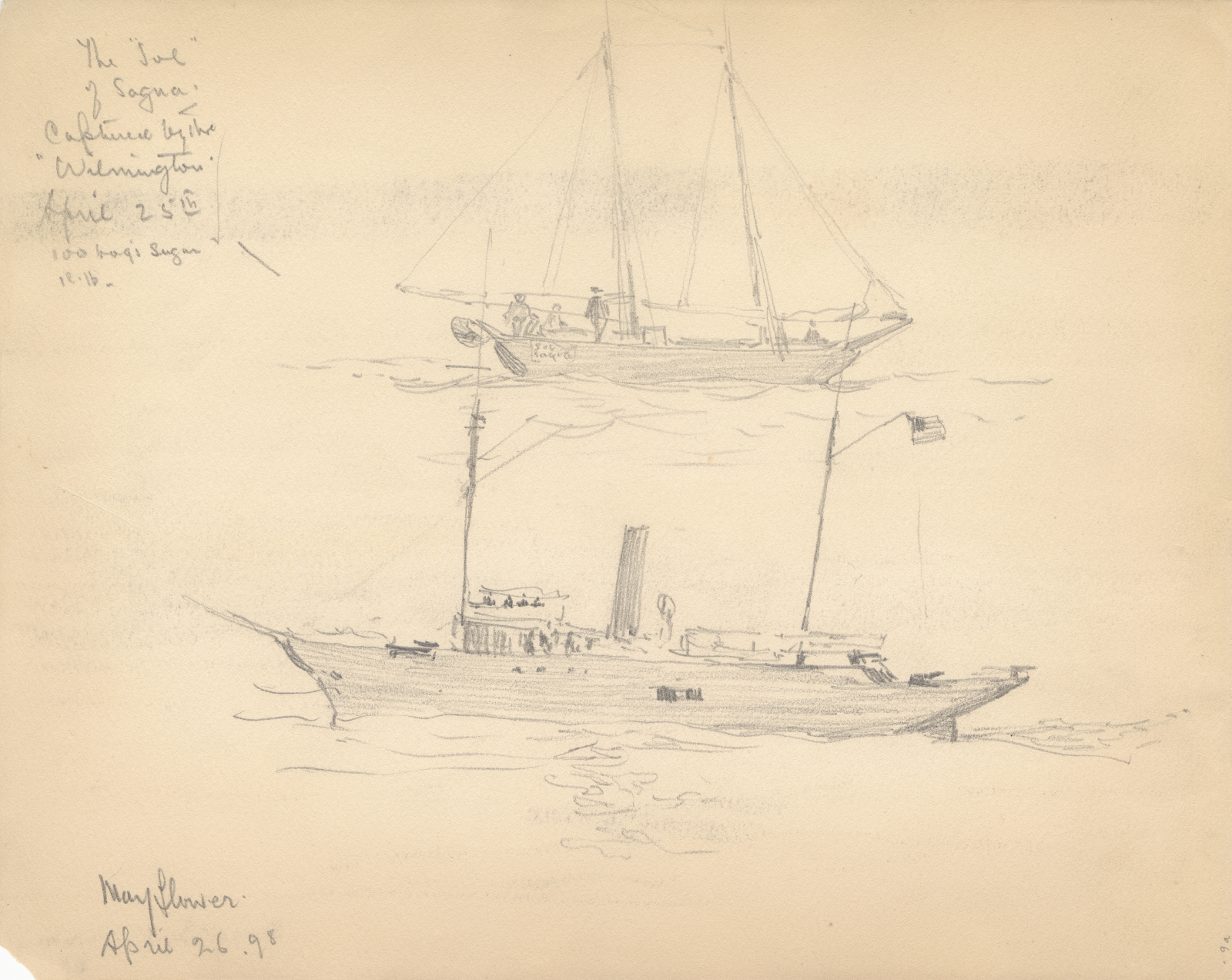
With the outbreak of the Spanish-American War the US Navy purchased Mayflower from the Goelet estate. The yacht joined Admiral Sampson’s squadron at the Havana harbor, capturing prize ships, firing on other ships, and helping to uphold the blockade. After the war, Mayflower served as Admiral Dewey’s flagship and then became a presidential yacht.
You can view images of Carlton Chapman’s published paintings about the war here .
In August 1905, USS Mayflower took part in another piece of international history: the Portsmouth Peace Treaty. The Russo-Japanese War of 1904-1905 had become a bit of a stalemate, and President Theodore Roosevelt stepped in to try and negotiate peace.
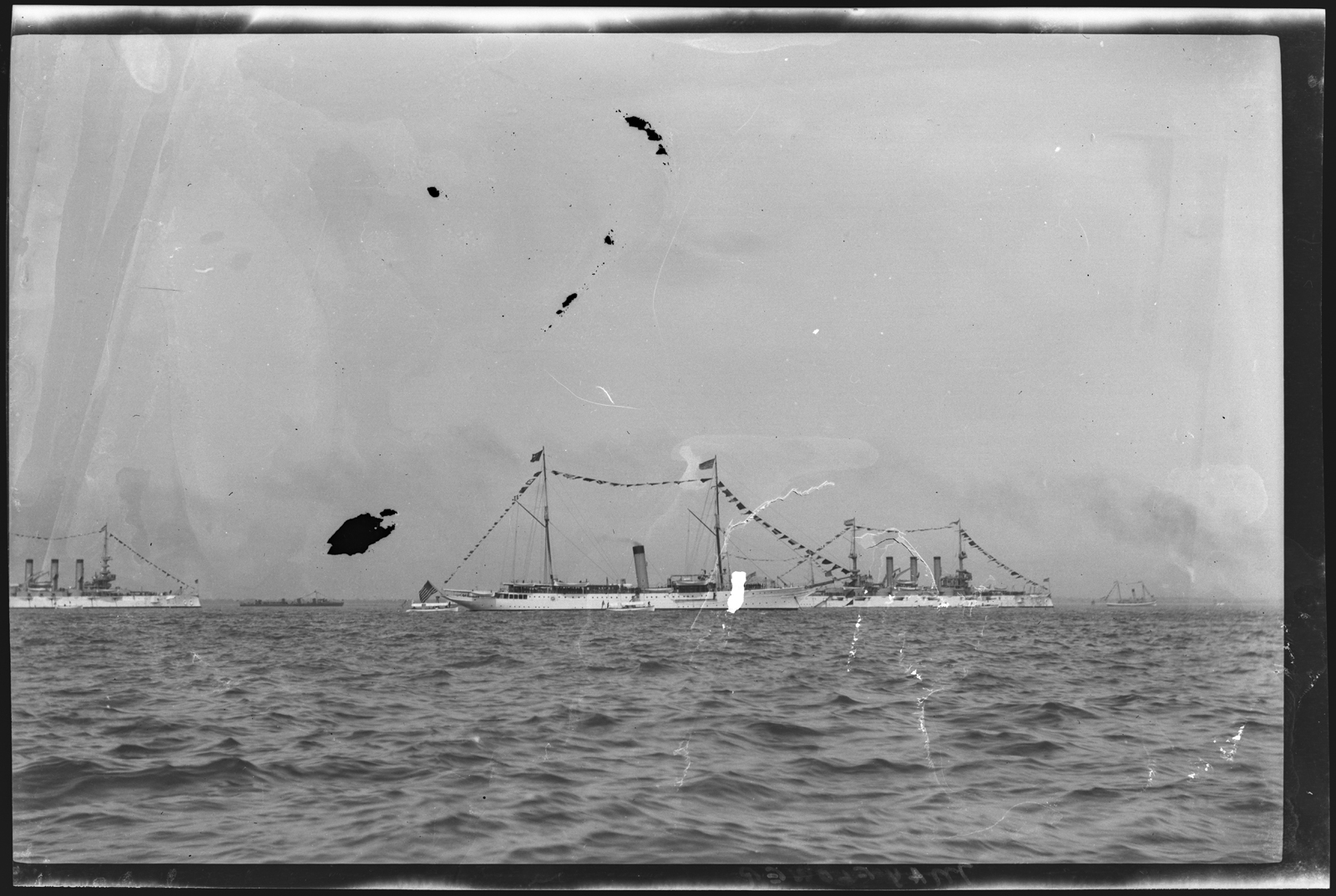
The Russian and Japanese envoys first met on board USS Mayflower in Oyster Bay, off the coast of Long Island near Roosevelt’s home. From there, they sailed separately to Kittery, Maine, with the Russians on USS Mayflower and the Japanese on USS Dolphin . The groups stayed at the Hotel Wentworth in Portsmouth, New Hampshire, and the negotiations continued at the Portsmouth Navy Yard in Kittery. Mayflower hosted social events as the negotiations proceeded. Thankfully, the two countries reached a consensus, ending the war and earning Roosevelt a Nobel Peace Prize in 1906.
You can learn more about USS Mayflower ‘s role in the Portsmouth Peace Treaty here , and about Roosevelt’s Nobel Prize here .
USS Mayflower was commissioned, decommissioned, and recommissioned several times in its lifetime and served as host to numerous diplomats. After WWI a fire in 1921 couldn’t slow the ship down for long. The ship participated in WWII, escorting ships and keeping an eye out for German submarines along America’s coastline.
The End of the Legacy
In 1948 the ship carried Jewish refugees from Marseilles to Haifa, Israel, and then later served in the Israeli Navy. It was broken up in 1955 after nearly 60 years at sea, including three wars.

It is surprising that when I run across similar histories in several different states and museums, those histories have so many shared maritime connections. After all, we truly are all connected by the world’s waters, making us all Mariners!
Share this:

Find anything, super fast.
- Destinations
- Documentaries

‘A Warship Wearing a Tuxedo’: Top100 Nord Delivered
By George Bains
The 141.6m superyacht Nord , formerly Project Opus, left the Lurssen Yachts shipyard on 19th February to begin her maiden voyage. The Top100 superyacht features a stunning exterior and interior design by Italian studio Nuvolari-Lenard, adding Italian flair to the German efficiency of Lürssen.
Nuvolari-Lenard has penned a striking exterior profile with a remarkably unique bow design, ensuring that there is much more to be excited about Nord than her size. “Nord was designed with one idea in mind: she must cause strong emotions in every observer, not only through her sheer size, but with the design itself,” explains Dan Lenard. “No one should be left indifferent. Whether you like the design or not, it must strike you.
“Nord is a serious ship first and foremost, but she also transcends the traditional language of yacht design. She is a warship wearing a tuxedo, an explorer with the elegance of a gentleman’s yacht. We have entered a new direction in serious yacht design.”
Dan Lenard’s comments demonstrate the effort and intricate detail that has gone into building a superyacht that embodies traditional sophistication and the modern quest for exploration. This, as Peter Lürssen says, is the result of a collaborative approach. “At Lürssen we believe that to build a yacht it is vital to work as a team, and to execute such a comprehensive project, an excellent team is necessary,” said the Lürssen Managing Partner.
In this case, Nord ’s team consisted of the design team from Nuvolari-Lenard, Moran Yacht & Ship who supervised the build on behalf of the Owner, and the project team from Lürssen. “We are looking forward to Nord finding her place amongst her peers as a remarkable statement in large yacht construction, based on a strong design and expert engineering skills.”
Moran Yacht & Ship brought in its vast experience and consolidated knowledge. Moran says: "We would like to take this opportunity to congratulate the Owner of Nord on the delivery of his new vessel. Additionally, we would like to thank the workers of the Lürssen shipyard, as well as the design and build team on this tremendous accomplishment."
At 141.6m in length and with a gross tonnage of 9,250, Nord is no doubt an exciting addition to the Top100 largest superyachts in the world.
"She is a warship wearing a tuxedo, an explorer with the elegance of a gentleman’s yacht." Dan Lenard
"She is a warship wearing a tuxedo, an explorer with the elegance of a gentleman’s yacht."
More news About…
Companies linked to this story, yachts in this story, more news from ..., new launches.

- Search Experiences
- Manage Booking
- Phone # SMS #
- My Offers 5
The History of John Wayne’s Yacht – Tour and Cruise the Wild Goose


Featured in this post
Newport Beach, CA
Newport Beach John Wayne Celebration Premier Brunch Cruise
Newport Beach John Wayne Celebration Premier Dinner Cruise
Keep Exploring
Essential Newport Beach
Explore More
“Whoa, take ‘er easy there, Pilgrim.” Who would have thought, the man famous for riding in on horseback, also loved to ride in… on the water? Really and truly, who doesn’t love cruising on a yacht? Marion Robert Morrison, more famously known as John Wayne , is one of the biggest actors of yesteryear. The star of classic blockbusters such as The Searchers, True Grit, El Dorado, and The Longest Day, loved to spend his free time on the water.
The Duke’s (a nickname given to him when he was young, and couldn’t be spotted anywhere without the family dog, “Duke”) passion for the water began early on in his life. Born in Iowa in 1907, John’s family moved to Glendale, California in 1914. He later attended the University of Southern California on a football scholarship, and very likely could have pursued that as a career, until suffering a bodysurfing accident that forced him to stop playing, and pursue a new career. So technically, if it wasn’t for his love of the water, we may not have ever known Marion as “John Wayne”. With his successful movie career, John’s passion for the water never left, inspiring him to purchase his beloved yacht, Wild Goose .

The History of Wild Goose
Before she became John Wayne’s yacht, Wild Goose was a warship. Built in 1942, the ship was originally a U.S. Navy Yard Mine Sweeper known as USS YMS-328 . The 136-foot ship sailed in World War II and served the Aleutian Islands in Alaska and the surrounding areas. After WWII, USS YMS-328 was decommissioned in 1946 and later sold. After going through a couple of different owners, she was eventually purchased for $116,000 by John Wayne in 1962 and then underwent a serious and expensive renovation.
Cool Features of the Wild Goose
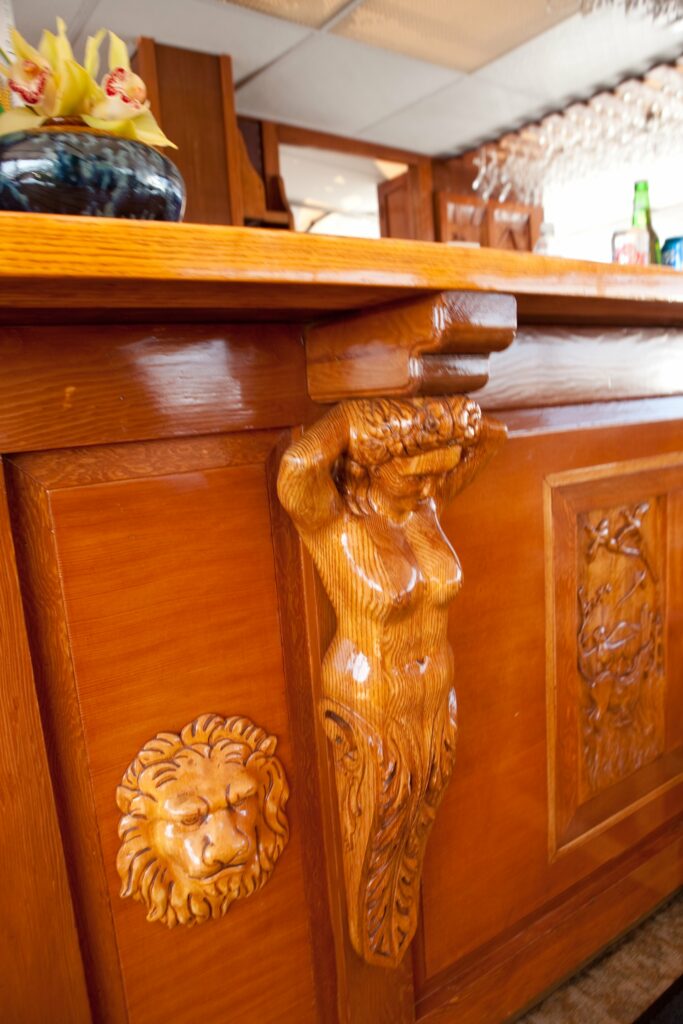
Life Onboard
From friendly fishing trips to Cataline cruises, this yacht perfectly symbolized Wayne’s social life. The Duke loved to play host to a variety of movie stars, musicians, professional athletes, and politicians such as Frank Sinatra, Dean Martin, Henry Fonda, Sammy Davis Jr., Ronald Reagan, and Richard Nixon. Some of his celebrity pals would even charter the boat themselves, including Tom Jones, the band America, and Dennis Wilson of The Beach Boys. Much like her owner, Wild Goose also became a movie star, appearing in The President’s Analyst in 1967 and Skidoo in 1968.

The Legacy of the Wild Goose
Even though he often said he would never sell Wild Goose , shortly before his death in 1979, Wayne sold the yacht to help get his affairs in order. After exchanging a few hands of ownership again, the vessel found a new home with Hornblower in 1996.

Since Wayne’s ownership, more changes and renovations have been made to Wild Goose , however with an attempt to keep it as original as possible. “Remnants of Wayne’s presence exist both through efforts to preserve the boat as he had it and modern touches that remind visitors whose yacht they are on.”, mentions The Orange County Register . “The balance is apparent in the Fireplace Room. A naval battle mural Wayne commissioned faces the wood-burning fireplace, while framed movie posters of his films line the worn, white walls on either side.” And with all of the stories those walls could tell, it’s a no-brainer to see why Wild Goose was honored with an addition to the National Register of Historic Places in 2011.

Original Post Date: May 31, 2023
Be the first to get offers and news
Shopping cart, find your experience.
- The U-boats
Allies in WWII
- Ships hit by U-boats
- Warship losses
- Warship types
- Warship classes
- Recent updates
- Wartime histories
- Allied Commanders
- Ships & Navies
- Aircraft & Air Forces
- Weapons & Techn.
Warship finder
Allied events.
What happened on 25 April?
See main event page
Allied Warships
Hms conqueror (fy 006 / f 33), armed yacht, commands listed for hms conqueror (fy 006 / f 33).
Please note that we're still working on this section and that we only list Commanding Officers for the duration of the Second World War.
You can help improve our commands section Click here to Submit events/comments/updates for this vessel . Please use this if you spot mistakes or want to improve this ships page.
Notable events involving Conqueror include:
18 Nov 1939 HMS H 32 (Lt. R.F. Jenks, RN) conducted A/S exercises off Portland with HMS Conqueror (Capt.(Retd.) E.T.R. Chambers, RN). ( 1 )
20 Nov 1939 HMS L 27 (Lt. P.J. Cowell, RN) conducted A/S exercises off Portsmouth with HMS Khartoum (Cdr. D.T. Dowler, RN) and HMS Conqueror (Capt.(Retd.) E.T.R. Chambers, RN). ( 2 )
21 Nov 1939 HMS L 27 (Lt. P.J. Cowell, RN) conducted A/S exercises off Portsmouth with HMS Puffin (Lt.Cdr. Hon. J.M.G. Waldegrave, RN) and HMS Conqueror (Capt.(Retd.) E.T.R. Chambers, RN). ( 2 )
7 Dec 1939 HMS H 31 (Lt. P.R. Ward, RN) conducted A/S exercises off Portland with HMS Puffin (Lt.Cdr. Hon. J.M.G. Waldegrave, RN) and HMS Conqueror (Capt.(Retd.) E.T.R. Chambers, RN). ( 3 )
10 Jan 1940 HMS H 50 (Lt.Cdr.(Retd.) J.R.G. Harvey, RN) conducted A/S exercises off Portland with HMS Kimberley (Lt.Cdr. R.G.K. Knowling, RN) and HMS Conqueror (Capt.(Retd.) E.T.R. Chambers, RN). ( 4 )
22 Jan 1940 HMS H 31 (Lt. P.R. Ward, RN) conducted A/S exercises off Portland with HMS Conqueror (Capt.(Retd.) E.T.R. Chambers, RN). ( 5 )
6 Mar 1940 HMS H 32 (Lt. M.D. Wanklyn, RN) conducted A/S exercises off Portland with HMS Valena (Capt. W.H. Poole, RNR) and HMS Conqueror (Capt.(Retd.) E.T.R. Chambers, RN). ( 6 )
8 Mar 1940 HMS H 32 (Lt. M.D. Wanklyn, RN) conducted A/S exercises off Portland with HMS Valena (Capt. W.H. Poole, RNR) and HMS Conqueror (Capt.(Retd.) E.T.R. Chambers, RN). ( 6 )
28 Mar 1940 HMS H 32 (Lt. M.D. Wanklyn, RN) conducted A/S exercises off Portland with HMS Conqueror (Capt.(Retd.) E.T.R. Chambers, RN) and HMS St. Modwen (Cdr.(Retd.) W.A. Ford, RN). ( 6 )
22 Apr 1940 HMS H 32 (Lt. M.D. Wanklyn, RN) conducted A/S exercises off Portland with HMS Conqueror (Capt.(Retd.) E.T.R. Chambers, RN). ( 7 )
4 Jul 1940 HrMs O 10 (Lt.Cdr. G. Quint, RNN(R)) participated in A/S exercises off Portland together with HMS Conqueror (Capt.(Retd.) E.T.R. Chambers, RN). ( 8 )
5 Jul 1940 HrMs O 10 (Lt.Cdr. G. Quint, RNN(R)) participated in A/S exercises off Portland together with HMS Conqueror (Capt.(Retd.) E.T.R. Chambers, RN). ( 8 )
4 Oct 1943 HMS Tradewind (Lt.Cdr. S.L.C. Maydon, DSO and Bar, RN) departed Dartmouth for Holy Loch. She was escorted by the French submarine chaser Chasseur 12 until 1725/4 when HMS Conqueror (T/Lt. T.W. Craig, RNR) took over the escort. Also HMS Clyde (Lt.Cdr. R.S. Brookes, DSC and Bar, RN) joined for the passage north. ( 9 )
4 Oct 1943 HMS Clyde (Lt.Cdr. R.S. Brookes, DSO, DSC, RN) arrived at Falmouth, U.K. from New London, U.S.A. She was escorted in by HMS Conqueror (T/Lt. T.W. Craig, RNR). ( 10 )
21 Aug 1945 HMS Upshot (Lt. A.J. Boyall, RN) conducted A/S exercises off Plymouth with HMS Holmes (T/A/Lt.Cdr. P.S. Boyle, RNVR), HMS Cosby (Lt. L.A. Pepperell, RN) and HMS Conqueror (T/A/Lt.Cdr. S.R. Brown, RNVR). ( 11 )
- ADM 173/15698
- ADM 173/15781
- ADM 173/15690
- ADM 173/16327
- ADM 173/16274
- ADM 173/16285
- ADM 173/16286
- File 2.12.03.6375 (Dutch Archives, The Hague, Netherlands)
- ADM 173/18249
- ADM 173/17745
- ADM 173/20194
ADM numbers indicate documents at the British National Archives at Kew, London.
Return to the Allied Warships section
Royal Navy warship rescues five people on sinking yacht
- Published 11 November 2022
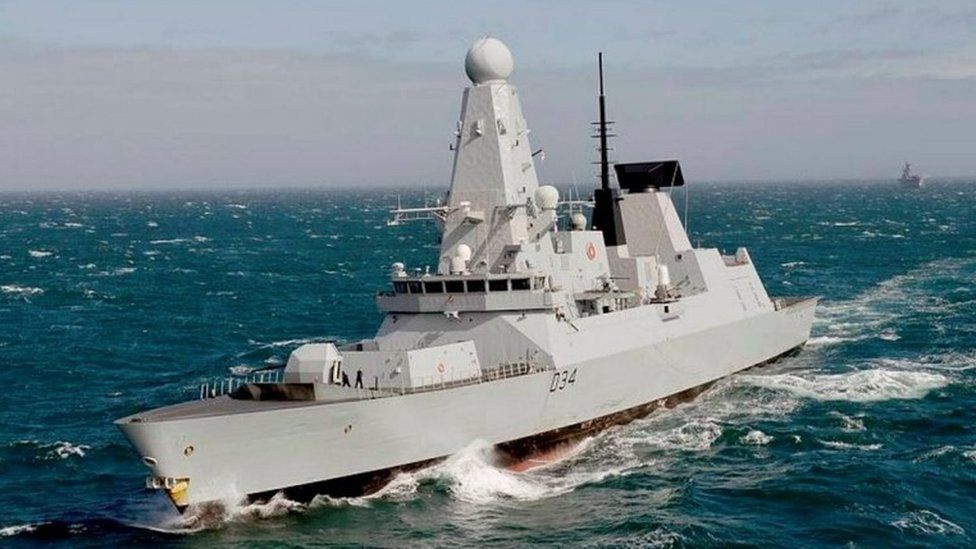
A Royal Navy destroyer rescued five sailors on a yacht which began to sink in the English Channel.
The craft, travelling from Beaulieu in Hampshire to France, issued a Mayday call at 21:00 GMT on Thursday.
HMS Diamond launched an inflatable boat in rough seas to rescue four badly seasick crew members, the RNLI said.
Four Royal Navy sailors then used buckets and hand pumps to remove water from the vessel while its captain sailed to Portsmouth.
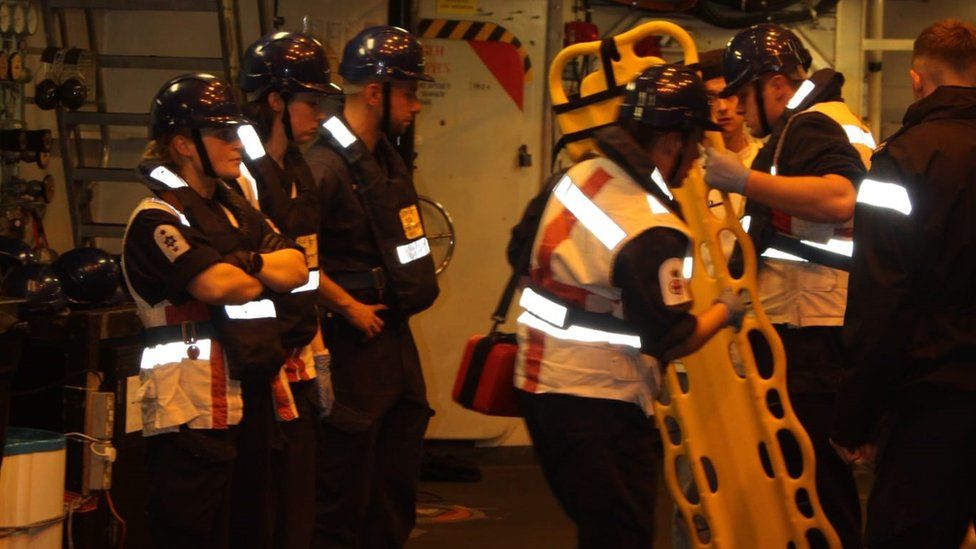
The stricken 12m (39ft) yacht was 33 miles (53km) south of Newhaven, East Sussex, when it sprang a leak, the RNLI said.
Lewis Arnold, from the RNLI's Newhaven lifeboat, said the Royal Navy managed to bring a small craft alongside the yacht and rescue most of the crew despite a 4m [13ft] swell.
He said: "We took four adults from the warship - a family group who were seasick.
"There were eight to 10 inches [20-25cm] of water above the decking [on the yacht]."
A lifeboat from Bembridge RNLI, on the Isle of Wight, was also sent to the scene and escorted the yacht to Haslar Marina.
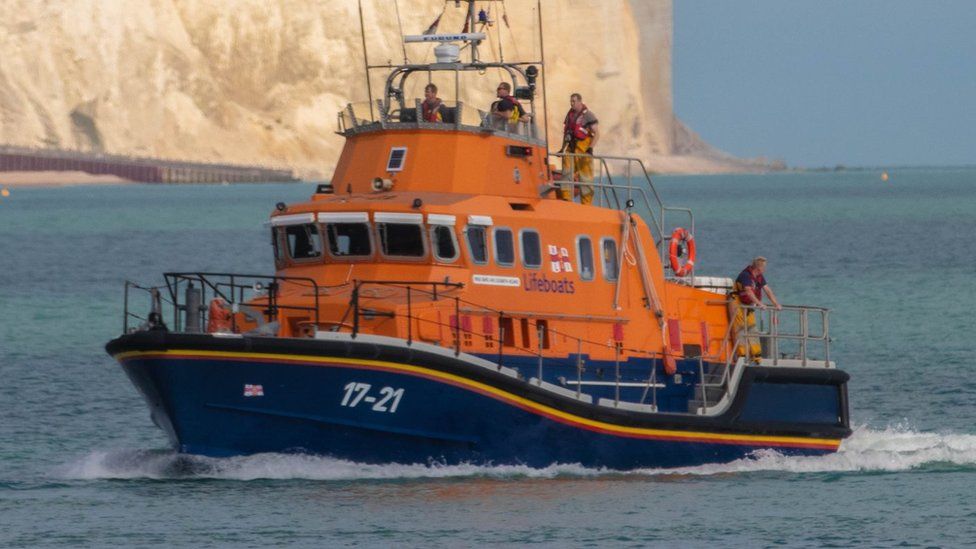
Follow BBC South on Facebook , Twitter , or Instagram . Send your story ideas to [email protected] .
Related Topics
- Hampshire & Isle of Wight
Warship rescues yacht crew in Atlantic
- Published 12 February 2017
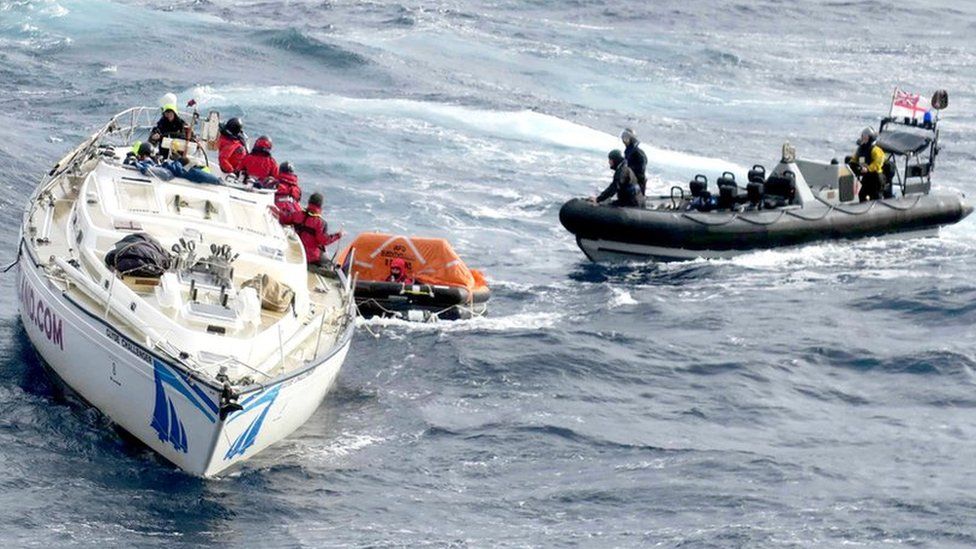
Related Internet Links
HMS Diamond - Royal Navy
Royal National Lifeboat Institution
Russia-Ukraine War Ukrainian Drones Hit 2 Bases Deep in Russia
- Share full article
- Saratov Oblast, Russia Explosion rocks Russian military base. EYEPRESS via Reuters
- Kyiv Residents take shelter in the Metro. Laura Boushnak for The New York Times
- Irpin Winter in Ukraine. David Guttenfelder for The New York Times
- Kherson region Salvaging a refrigerator from the ruins of a home. Finbarr O'Reilly for The New York Times
- Borodyanka A makeshift center for those whose homes have been destroyed. Dimitar Dilkoff/Agence France-Presse — Getty Images
- Kharkiv Police officers look at collected fragments of Russian rockets. Libkos/Associated Press
- Bakhmut Chopping wood in a basement shelter. Tyler Hicks/The New York Times
- Donetsk An office building destroyed in shelling. Alexander Ermochenko/Reuters
- Eastern Ukraine Soldiers on the front line. Yevhen Titov/Agence France-Presse — Getty Images
Follow live news updates on the Russia-Ukraine war .
Ukraine attacks military bases hundreds of miles inside Russia.

KYIV, Ukraine — Ukraine executed its most brazen attack into Russian territory in the nine-month-old war on Monday, targeting two military bases hundreds of miles inside the country, using drones, according to the Russian Defense Ministry and a senior Ukrainian official.
The drones were launched from Ukrainian territory, and at least one of the strikes was made with the help of special forces close to the base who helped guide the drones to the target, said the official, speaking on the condition of anonymity to convey sensitive information.
The strikes signaled a new willingness by Kyiv to take the fight to bases in the heart of Russia, raising the stakes in the war, and demonstrated for the first time Ukraine’s ability to attack at such long distances. Shortly after the attacks on the bases, Russia sent a barrage of missiles streaking toward Ukrainian cities.
The Kremlin said that the weapons launched by Ukraine were Soviet-era jet drones and were aimed at bases in Ryazan and Engels, about 300 miles from the Ukrainian border. It said that its forces had intercepted the drones, and that “the fall and explosion of the wreckage” had “slightly damaged” two planes, killing three servicemen and wounding four others.
The Engels airfield, on the Volga River in southern Russia, is a base for some of Russia’s long-range, nuclear-capable bombers, including the Tupolev-160 and Tupolev-95. Ukrainian officials say it is also a staging ground for Russia’s unrelenting campaign of missile attacks on infrastructure, which have left millions of Ukrainians with intermittent light, heat or water — or none at all — at the onset of winter. Security footage from an apartment complex near the base showed a fireball lighting up the sky.
The other explosion occurred at the Dyagilevo military base in the central city of Ryazan, only about 100 miles from Moscow, according to Russia’s Defense Ministry. It was there that the fatalities and injuries occurred, the Russian state news agency RIA Novosti reported.
Ukraine’s government declined to publicly acknowledge the strikes, in keeping with its practice with other attacks on Russia and Russian-occupied Crimea.
The Engels air base and the Ryazan military installation are between 300 and 450 miles from the Ukrainian border, which is beyond the range of any known missile in Ukraine’s arsenal.
Even before Russia’s Defense Ministry accused Ukraine of sending drones to attack, the blast at the Engels airfield had prompted some of Russia’s influential pro-invasion bloggers to call for more strikes against Ukraine, and to renew criticism of the Russian armed forces. “Sometimes we feel that even if you put a bomb into these people’s pockets — they wouldn’t notice anyway,” Voenniy Osvedomitel, a popular commentator, wrote on the messaging app Telegram.
After the explosions, Mykhailo Podolyak, an adviser to Ukraine’s president, appeared to note the strikes obliquely, as Ukrainian officials have often done after unexplained explosions inside Russia.
“The Earth is round — discovery made by Galileo,” he wrote on Twitter . “If something is launched into other countries’ airspace, sooner or later unknown flying objects will return to departure point.”
Only a few hours after the explosions, Ukrainian officials said that more than a dozen Russian bombers had taken off from the Engels air base.
Ivan Nechepurenko and Helene Cooper contributed reporting.
— Andrew E. Kramer , Michael Schwirtz and Marc Santora
Russia fired a barrage of missiles across Ukraine on Monday.
Russia launched a volley of missiles at Ukraine’s energy grid on Monday, knocking out power in several regions, officials said, the latest in a monthslong campaign of strikes by Moscow targeting civilian infrastructure.
Ukrainian air defense systems fired into the sky in multiple areas of the country but not all missiles were intercepted. Four people were killed by the Russian strikes, President Volodymyr Zelensky said, and officials reported damage to energy infrastructure.
When air-raid warnings were issued for most of the country, Ukrainians followed a grim routine and headed for bomb shelters in Kyiv and other cities. Shortly after the all-clear was given, Mr. Zelensky addressed the nation to praise both the military and utility workers fighting to keep the lights on.
“Air defenses shot down most of the rockets, energy workers have already started to restore electricity,” he said. Ukraine’s Air Force later said that it had shot down more than 60 missiles out of more than 70 fired.
Russia’s Ministry of Defense said in a statement that it had targeted power plants and other sites in Ukraine. Ukraine’s prime minister said energy facilities were hit in the Kyiv, Vinnytsia and Odesa regions, according to the Ukrinform news agency.
The strikes occurred hours after explosions were reported at two military bases deep inside Russia, including one that Ukraine said has been used as a staging ground for aircraft in previous attacks against Ukraine’s energy grid. Russia’s Ministry of Defense later accused Ukraine of using drones to attack the bases.
By midafternoon in Ukraine, multiple reports had surfaced of inbound missiles. A New York Times reporter south of Kyiv saw a cruise missile in flight traveling toward the capital. Another New York Times reporter observed what appeared to be a surface-to-air-missile launched outside of Sloviansk in eastern Ukraine. The extent of damage, and of casualties, was not immediately clear.
The governor of the Kyiv region, the administrative district around the capital, said that air defense systems had fired at incoming missiles. “Stay in shelters and safe places,” the governor, Oleksiy Kuleba, wrote in a statement on Telegram.
Ukraine’s national energy company, Ukrenergo, said that the “mass missile attack” had damaged electrical facilities. In a statement posted on Facebook , it said emergency energy shutdowns would be imposed to help balance the grid.
Blackouts were reported in several regions, from Sumy in the north along the border with Russia to Odesa in the south on the Black Sea coast.
The Russian military typically launches missiles from multiple directions and in successive waves, a tactic intended to overwhelm or avoid Ukraine’s air defenses, Yuriy Ihnat, a spokesman for the Ukrainian Air Force, told a Ukrainian television news show.
Russia began firing missiles at Ukraine’s energy grid in October after its forces lost ground on the battlefield in two Ukrainian counteroffensive operations in the south and northeast.
Ukrainians have responded to the wave of strikes on infrastructure by building emergency heating shelters in towns, dispatching linemen to repair the grid as swiftly as possible and powering restaurants, stores and hospitals with generators . In hard-hit areas, residents stockpile water in bottles in their homes.
And Ukrainians have adapted. In Kryvyi Rih, a central city that is a hub of the iron-mining industry, miners evacuated to the surface on Monday, lest electricity for their elevators be lost, the city’s mayor said. After past strikes, miners had been trapped underground.
Ukraine has greatly increased its capacity to shoot down incoming missiles, aided by air defense systems supplied by the United States and some European countries..
Carlotta Gall and Thomas Gibbons-Neff contributed reporting.
— Andrew E. Kramer and Matthew Mpoke Bigg
Advertisement
When the air raid sirens ring out, residents of Kyiv head underground.

KYIV, Ukraine — In a city where daily routines have been wrecked by unrelenting Russian missile strikes, unpredictable power cuts and unreliable water supplies, residents of Kyiv know that, at any time, they might have to spend a few hours in an air raid shelter.
It had been 13 days since the last large-scale barrage of Russian missiles fired at targets across Ukraine, the longest stretch without blasts in and around the capital since Moscow began its assault on the nation’s energy infrastructure in early October. For days, Ukrainian officials had been warning that another attack was imminent.
So when the air raid alarms sounded across Kyiv early on Monday afternoon, many people were not surprised. The sirens were followed by warnings that missiles were inbound, and soon after the thunder of air defense systems could be heard over the capital.
“To be honest I feel relief this time,” said Olha Kotrus, 34. “For two weeks there were reports that it might happen and then you live in constant tension.”
Ms. Kotrus was sitting on the floor of a Kyiv metro station with her mom, a cat in a cage and her dog. The dog, dressed in a blue outfit to keep it warm in the winter chill, was visibly stressed. Ms. Kotrus was angry and fed up.
She joined a crowd of hundreds people deep underground at the metro station Golden Gate, named after the main fortification that served as the entrance to the city 1,000 years ago.
By evening, however, the famed gate was not illuminated, forced into darkness like much of the city. Monday’s barrage of rockets targeting sites around the country was the eighth such wave of attacks on key energy infrastructure targets, according to the national utility operator, Ukrenergo.
“Unfortunately, energy infrastructure facilities have already been hit and there have been emergency power outages related to this,” Ukrenergo said in a statement.
At least ten rockets were aimed at Kyiv on Monday, according to local officials. Nine were shot down above the capital, the officials said.
Like everyone interviewed in Kyiv, Ms. Kotrus’s anger was directed at Russia and her frustration was the result of many days filled with anxiety and long, dark nights with no power.
Anna Sokolova, 21, said she had endured cuts in power and water supplies for two weeks, ever since the last wave of missiles. Ms. Sokolova lives near a local utility headquarters that has been targeted in recent Russian strikes and said she always takes shelter when the alarms sound.
But she did not want to complain about her own hardships, saying it is nothing compared to what her friends, soldiers fighting on the front lines, are experiencing.
Lyumyla Vonifatova, 66, agreed.
“We all understand that without electricity, life becomes impossible,” she said. “Yet, we will just have to find a way to get through it.”
She was passing the time in the subway shelter by looking at a small display of photos of this war and others that came before it.
“Despite all the loss of human life and economic hardship, we will stand until the end,” she said. “Because this is a fight for our freedom.”
But Tetyana Tkachenko’s six-year-old son is too small to understand that. She said he is terrified every time the alarms sound.
“He was crying, running around,” when the alarms began to sound, Ms. Tkachenko said. He quickly put on warm clothes and begged to “go to the subway,” she said.
She grabbed two foldable chairs, previously used for the park or beach. But now they were part of the family’s new routine, for when the sirens sound and they head deep underground.
— Marc Santora and Maria Varenikova
Putin inspects a bridge linking Russia and Crimea, two months after a damaging explosion.
President Vladimir V. Putin inspected repairs to a bridge that links the country with the Crimean Peninsula on Monday, two months after an explosion partly destroyed it in an embarrassing blow to the Russian leader and Moscow’s war effort in Ukraine.
The October attack on the Kerch Strait Bridge, a pet project of Mr. Putin’s that became a key supply route for Moscow’s forces in southern Ukraine, was a critical moment in the war. The Kremlin accused Ukraine of orchestrating the blast, which underscored Russia’s inability to protect a key strategic asset and prompted Moscow to unleash a wave of airstrikes on Ukraine.
Video published by the Kremlin showed Mr. Putin driving a Mercedes car over the bridge. Accompanied by Deputy Prime Minister Marat Khusnullin, who is in charge of the repair, Mr. Putin inquired about the progress of the work and said he hoped the road and rail bridge would be fully restored by the middle of the summer vacation season.
Pointing at the still-charred railway section of the bridge, he said that “this was a big explosion.”
When the bridge opened in 2018, it was a powerful symbol of the connection the Kremlin was attempting to forge between Russia and Crimea, a Ukrainian region illegally annexed by Moscow four years earlier. Mr. Putin took personal credit for its construction, driving a truck along its 12-mile span at the head of a convoy.
On Monday, he also took credit for building two railway tracks and two traffic lanes each way, as the redundancy allowed traffic to be partially restored soon after the explosion hit in October.
While Ukraine’s government did not claim responsibility for the blast, which sent part of the bridge crashing into the sea on Oct. 8, a senior Ukrainian official, who spoke on the condition of anonymity because of a government ban on discussing the blast, confirmed that Ukraine’s intelligence services were behind it .
The Kerch attack came during a period of setbacks for Russian forces in Ukraine, including the loss of territory it had captured in the northeast of the country. Two days after the attack on the bridge, Russia escalated a strategy of pounding Ukraine’s energy infrastructure with waves of missiles launched at power stations and other facilities.
— Matthew Mpoke Bigg and Ivan Nechepurenko
A woman is shot and killed trying to cross into Ukrainian-held territory in Kherson.
KHERSON, Ukraine — A 65-year-old woman was shot to death on Sunday evening as she tried to escape in a boat from Russian-occupied territory in Kherson, Ukrainian officials said, illustrating the perils of Ukraine’s call for civilians to evacuate Russian-held areas in the heavily contested southern region.
Ukrainian officials blamed Russian soldiers in the killing; there was no immediate comment from the Russian side. The woman was crossing the Dnipro River, attempting to thread a gantlet of Russian and Ukrainian troops dug in on opposite banks near the city of Kherson, when she was killed in a hail of automatic gunfire, according to a statement from the City Council.
Both armies have been heavily shelling each other across the river, which has become a front line three weeks after Ukraine reclaimed Kherson city on the west bank and Russian forces withdrew to defensive positions on the eastern side. On Saturday, Ukrainian officials encouraged people to flee Russian-occupied areas on the eastern bank, warning of a “possible intensification of hostilities.”
But even before the woman was killed, many Ukrainians had complained on social media channels that the evacuation plan, which required individuals to use private boats to cross a dangerous river, was poorly organized. The announcement on Saturday did not specify the areas people should flee from or whether the advice applied in towns still occupied by Russian troops.
One of those towns, Hola Prystan, which lies several miles downriver from Kherson, was the area that the woman who was killed tried to escape, according to a statement released by the Kherson City Council on Sunday night.
“A 65-year-old woman who was crossing the Dnipro River with her husband on a boat, leaving a country house in the Hola Prystan district, was wounded by automatic fire. Unfortunately, the woman did not survive,” the statement read.
On Monday, Oleksandr Tolokonnikov, a spokesman for the Kherson regional military administration, said that the area was not covered by the evacuation plan.
“Navigation there is not open,” he said. “It is still banned to cross river there by boats. People can move there at their own risk.”
The area around Kherson and Hola Prystan is a watery landscape of river channels and small marshy islands, some with summer homes on them. The Kherson authorities’ plan was to have evacuees come to Kherson’s main river port, which itself has come under heavy shelling in the past week. Until the evacuation was announced, the Ukrainian military had prohibited people from traveling by boat on the river. The plan was to allow daylight river crossings for three days, Saturday, Sunday and Monday.
The mood in Kherson has turned grim in the three weeks since Ukrainian forces swept in, when the city throbbed with jubilation as people poured into the streets, hugged soldiers, waved flags and snapped selfies. As Russian forces continue to shell the city relentlessly, more than 18 people have been killed in the past two weeks and dozens more wounded, according to Ukrainian officials.
Ukrainian forces have been eager to push the Russians farther away and get Kherson out of artillery range. Over the weekend, a Ukrainian military unit released a video purporting to show the raising of a Ukrainian flag on the eastern bank of the Dnipro. Although there was no indication that Ukraine had established a permanent military presence at the site, the video was an apparent sign of Kyiv’s intent to continue its counteroffensive in the south.
Oleksandra Mykolyshyn contributed reporting.
— Jeffrey Gettleman
An E.U. embargo of Russian oil and the G7’s price cap take effect.
Europe and the United States started enforcing on Monday two of the toughest measures aimed at curbing Russia’s income from oil, the principal source of cash used to fund its nearly 10-month-old war in Ukraine.
The first, a price cap initiative led by the United States, aims to increase economic pressure on the Kremlin while avoiding a global oil shock . The limit was set at $60 per barrel, and was endorsed by the Group of 7 countries, Australia, and members of the European Union.
The second is an embargo under which European nations will no longer be able to buy most Russian crude as of Monday. It was a step that the European Union had agreed to months ago but that was phased in with exceptions to prepare member nations.
Prices gyrated in the oil markets on Monday, with Brent crude, the international benchmark, up by about 2.5 percent, to $87.75 a barrel, at midday in Europe. West Texas Intermediate future were selling at $82 a barrel.
An immediate impact on oil supplies in Europe was not expected, partly because the embargo has been in the works for months, and energy companies have already begun buying more oil from the United States, Brazil, Guyana and the Middle East.
Although analysts and traders say the price cap may prove a nightmare to administer, one expert on sanctions said the lengthy negotiations had produced a deal with the potential to work.
“I suspect the compromise that was reached gives the policy the best chance it could have to succeed,” said Edward Fishman, a senior research scholar at Columbia University’s Center on Global Energy Policy.
Mr. Fishman, who previously led planning and implementation of sanctions on Russia at the Department of State, said there were several reasons to be optimistic. One is the recent softness of oil markets, which he interpreted as meaning that Russian oil was no longer as critical to the markets as it was a few months ago. He also said the agreed $60 price was a “Goldilocks” level, not so high as to give Russia even more revenue than it is currently receiving or so low as to discourage Moscow from producing oil.
He also said that the cap’s provision to review the price level every two months, or more frequently if needed, provided the “flexibility” that historically has helped make sanctions, like those targeting Iran’s oil sales, effective.
Still, skepticism about the likely efficacy of the measures stems in part from the United States and European countries mandating European shippers and insurers to enforce it by declining to handle cargoes priced above the $60-a-barrel level.
— Stanley Reed
Ukraine will auction a yacht seized from a Putin ally.
As Ukraine scrambles to fund its fight against Russia’s invasion, a potential new source of tens of millions of dollars has materialized — the planned sale of a superyacht seized from one of Ukraine’s most famous pro-Russian oligarchs.
Soon after Russia began its full-scale invasion of Ukraine in February, Ukrainian authorities announced they had taken possession of properties belonging to Viktor Medvedchuk , a prominent pro-Russian politician and a close friend of President Vladimir V. Putin of Russia.
For years, Mr. Medvedchuk was seen as the Kremlin’s primary agent of influence in Ukraine. Mr. Putin is the godfather of Mr. Medvedchuk’s daughter.
The confiscated assets included the Royal Romance, a 300-foot yacht docked in a Croatian port that is linked to Mr. Medvedchuk. According to its Dutch manufacturer, Feadship, the ship has a 40-foot swimming pool, a gym, a waterfall feature, and an estimated value of more than $200 million. The yacht and other assets were confiscated as part of a criminal investigation in which Mr. Medvedchuk is suspected of treason, according to Ukraine’s State Bureau of Investigation .
Last week, ARMA, Ukraine’s government agency for asset recovery and management, said that a district court in Split, Croatia, had entrusted the city’s port administration with implementing the transfer of the yacht to the agency. ARMA described the Royal Romance, which has 50 rooms, as “one of the largest yachts in the world” and said that it plans to auction the vessel to “preserve its economic value.”
Ukrainians welcomed the proposed sale, with some celebrating on social media and joking that Mr. Medvedchuk would be making a large donation to Ukraine’s armed forces.
ARMA was created in Ukraine in 2016 to seize the assets of officials in corruption cases, but since the invasion it has also turned its attention to the property of Russians and of Ukrainians who are accused of collaborating with Russia.
Mr. Medvedchuk, a prominent figure in the pro-Russian wing of Ukrainian politics and a former deputy speaker of Ukraine’s Parliament, had been under criminal investigation in Ukraine before the invasion. Ukrainian security forces captured him in April, after he fled house arrest while awaiting trial on treason charges. Ukrainian authorities handed him over to Russia in September in a prisoner exchange.
Mr. Medvedchuk was also mentioned in U.S. investigations into Russian electoral meddling, as a client of the Republican political consultant Paul Manafort. He denied wrongdoing and said Mr. Manafort had merely advised his party on electoral strategy.
The Royal Romance officially belongs to a company called Lanelia Holdings, based in the Marshall Islands, according to Equasis , a major shipping information database. The ship changed ownership in 2021, when Ukraine imposed sanctions on Mr. Medvedchuk.
Last summer, a superyacht linked to a Russian businessman under sanctions was auctioned in Gibraltar, but the profits were set to repay his creditors rather than replenish Ukraine’s accounts. In general, the process through which seized assets can be permanently confiscated and sold to benefit Ukraine is cumbersome and can take years .
— Emma Bubola and Anastasia Kuznietsova
To help Ukraine, a widow parts with a rare emerald from a 1622 shipwreck.
For years, Mitzi Perdue looked down at her hand and saw history.
The emerald stone on her ring finger told a story stretching back nearly four centuries, to the sinking of a Spanish galleon near the Florida Keys in 1622 and a decades-long effort of a colorful undersea treasure hunter named Mel Fisher to retrieve its payload of gold and silver coins, gold nuggets and jewelry.
It reminded her, too, of her late husband, the chicken magnate Frank Perdue, who received a share of the bounty in return for his investment in Mr. Fisher’s search. He donated most of it, but kept the emerald and presented it to her when he proposed marriage in 1988. She wore it until his death in 2005 , when she put it away for safekeeping.
Now, 400 years after the Nuestra Señora de Atocha sank in a hurricane, Ms. Perdue, 81, is putting the emerald up for auction on Wednesday at Sotheby’s in New York City. All proceeds from the sale of the ring, which Sotheby’s says has an estimated value of $50,000 to $70,000, will be donated to support humanitarian efforts in Ukraine, prompted by Ms. Perdue’s visit there this year after the Russian invasion .
“What must it be like for the people who have been there enduring, continuously with no respite, for at least half a year?” she said. “After five days, I wanted to do more. And then I started thinking, ‘What can I do to be most helpful?’ And then I thought, ‘I own something that’s of historic significance.’”
— April Rubin
Russia continues to manufacture cruise missiles despite Western sanctions, experts say.
Some of the cruise missiles that Russia launched at Ukraine’s civilian infrastructure in late November were manufactured months after the West imposed sanctions intended to deprive Moscow of the components needed to make those munitions, according to a weapons research group.
Experts examined remnants of Kh-101 cruise missiles found in Kyiv, the capital, after an attack on Nov. 23 that knocked out electricity and shut down water systems in large areas of the country. One of the missiles was made this summer, and another was completed after September, markings on the weapons show, according to a report released by the investigators on Monday .
That Russia has continued to make advanced guided missiles like the Kh-101 suggests that it has found ways to acquire semiconductors and other matériel despite the sanctions or that it had significant stockpiles of the components before the war began, one of the researchers said.
The findings are among the most recent by Conflict Armament Research , an independent group based in Britain that identifies and tracks weapons and ammunition used in wars. A small team of its researchers arrived in Kyiv just before the attack at the invitation of the Ukrainian security service.
— John Ismay
Ukraine hits Russian shipyard in Crimea port, damages ship
- Medium Text
Sign up here.
Reporting by Maria Starkova and Elaine Monaghan; Writing by Lidia Kelly; Editing by Philippa Fletcher, Ros Russell, Andrew Heavens and Daniel Wallis
Our Standards: The Thomson Reuters Trust Principles. New Tab , opens new tab

World Chevron

Indigenous people protest Brazil not protecting ancestral lands
Several thousand Indigenous demonstrators marched chanting to drum beats on Thursday to the seat of power in Brazil's capital to protest against the government's failure to protect their ancestral lands.
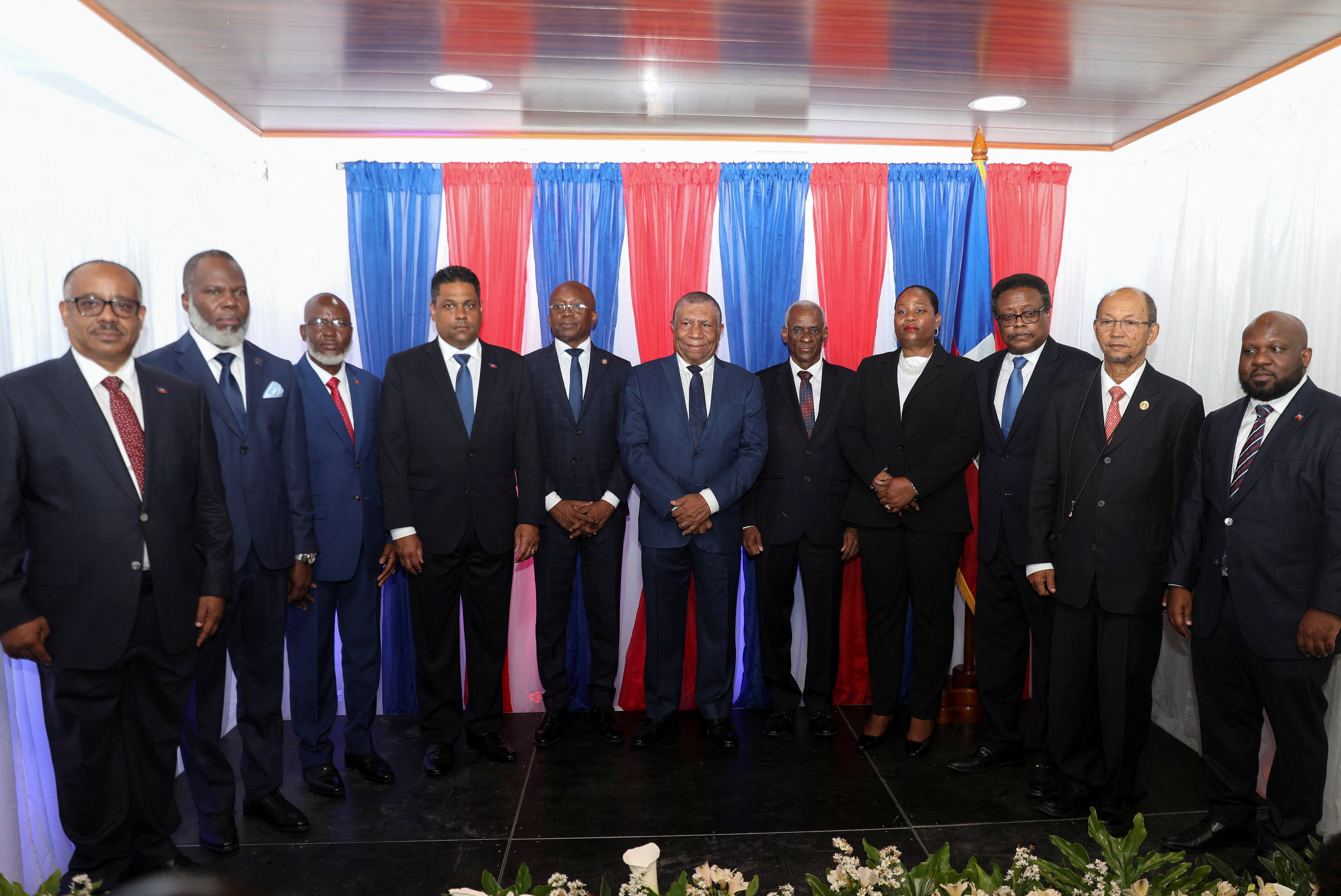
Wynyard boating deaths of Tasmanian trio 'wholly avoidable' and down to alcohol, illicit drugs, coroner finds
- In short: Three Tasmanian friends set out to sea after a night of drinking in 2021 and never returned, with a coroner finding they drowned.
- Alcohol and meth were detected in the bodies of two of the trio, which were found in the days after the incident
- What's next? A coroner has made no recommendations and found the deaths were "wholly avoidable", with no evidence of any bad weather at sea or third-party involvement.
The drowning of three people on a boat trip off Tasmania's north-west coast was "wholly avoidable" and down to "a combination of alcohol, illicit drugs and a failure to take basic safety precautions," a coroner has found.
Coroner Simon Cooper said Isaiah Solomon Dixon, Bree-Anna Mary Jennifer Thomas and Thomas Courto died of drowning on October 18, 2021, in the Bass Strait waters, near Table Cape.
In his report, released on Tuesday, Mr Cooper said Mr Courto and Mr Dixon arrived at the Wharf Hotel in Wynyard where Ms Thomas was working at 3pm on Sunday October 17, and "spent the rest of the afternoon and evening in the bar drinking and socialising".
After the hotel closed, Ms Thomas joined them on "the other side of the bar", where they drank with another friend, Ethan Jones, before leaving and continuing to drink at Mr Jones' home until at least 4am, where they made plans to take the boat out later that day.
On October 18, Ms Thomas, Mr Dixon and Mr Courto picked up the 17-foot fibreglass Caribbean half-cabin cruiser from Mr Dixon's father, who noticed his son appeared to have "had a few drinks".
The three then bought six four-packs of vodka cruisers and a 10-pack of cider, before heading to the Wynyard Auto and Fishing Supplies Shop, where Mr Dixon told the owner, James Lowe, that they were heading out on the water "for a fun drinking trip".
Although Mr Dixon had a motorboat licence and had previously owned a half-cabin runabout, Mr Lowe was "shocked" when Mr Dixon asked about the correct petrol-to-oil ratio, because it suggested he lacked boating experience.
He said he thought Mr Dixon appeared "drug or alcohol affected" and another witness said all three appeared "very intoxicated".
Mr Cooper found they left the Wynyard Yacht Club at 10am, stopping at the beach at Boat Harbour after a couple of hours, before embarking again.
Police immediately commenced a search after being notified at 5:35pm that the boat was overdue.
Two days later, searchers found Mr Dixon's and Ms Thomas's bodies on the shore between Table Cape and the mouth of the Inglis River, neither wearing a personal floatation device (PFD).
No evidence of Mr Courto's body was found until April 21 the following year, after his femur was recovered by a recreational diver below the Table Cape lighthouse.
The boat was never found.
Tragedy 'wholly avoidable'
The autopsies found at the time of death, Mr Dixon had a blood alcohol level of at least 0.110, and Ms Thomas 0.063. Methylamphetamine was also detected in both bodies.
The pathological cause of death was unable to be determined from Mr Courto's femur, however Mr Cooper said "it seems more likely than not that he also drowned".
"It is difficult to escape the conclusion that a combination of alcohol, illicit drugs and a failure to take basic safety precautions was the reason for these deaths," he said.
"There is no evidence that adverse weather conditions, the lack of a seaworthy boat or the actions of a third party caused or contributed to the deaths of Mr Dixon, Ms Thomas and Mr Courto.
"Rather, no-one was wearing a PFD and all were affected by alcohol, methylamphetamine and fatigue.
"Having regard to the evidence as a whole, it is my firm opinion that Mr Dixon, Ms Thomas and Mr Courto should not have been on the water that day.
"The tragedy was wholly avoidable."
Mr Cooper said there was no direct evidence to give a definite conclusion as to why the boat sank.
"However, in all the circumstances and having regard to the evidence as a whole, the most likely explanation is some type of mishap, probably as the result of poor boat handling, attributable to impairment caused by alcohol and illicit drugs," he said.
The coroner made no findings, but commented that had they been wearing PFDs, "it is likely each would have survived".
Mr Dixon's father said his boat, ED Dog, was powered by a 115hp Mercury two-stroke engine, but had no auxiliary engine, and was fitted with a two-way radio and navigation lights, and had PFDs, oars, flares, a fire extinguisher and an anchor onboard.
It is unclear whether or not the vessel carried an Emergency Position Indicating Radio Beacon, but there was no evidence that one was activated in the area where the three went missing.
- X (formerly Twitter)
Related Stories
Final farewell for son lost at sea in boating triple tragedy.
- Boat Harbour
- Maritime Accidents and Incidents

IMAGES
VIDEO
COMMENTS
A warship or combatant ship is a ship that is built and primarily intended for naval warfare. Usually they belong to the armed forces of a nation. As well as being armed, ... Armed yachts were modified yachts that were armed with weapons and were typically in the service of a navy.
NORD is a 464-foot-long Superyacht that looks like "warship wearing a tuxedo" Tom Van Oossanen. One of the many things I love about writing about superyachts is my eternal quest to find the right ...
These include Frigates, Corvettes, Destroyers, Cruisers, Submarines, Amphibious Warfare Ships, and Aircraft Carriers. Each type of warship plays an important role in overall naval operations ...
Read More / Iconic yachts: Inside the story of Lürssen's 114.5m superyacht Pelorus. The Lürssen shipyard, with its military expertise and discipline, was the ideal yard to build this most warship-like of private yachts, whose parameters include a guaranteed maximum speed and a range of 3,500 nautical miles at 18 knots. Ronin MTU 5,875hp diesel engines hum in polished splendour in an engine ...
The latest plan to design a future force calls for a fleet of 373 manned ships, buttressed by about 150 unmanned surface and underwater vehicles by 2045, according to Chief of Naval Operations Adm ...
The ship was in service until 1998 when its owner decided to convert the vessel into a luxury per-cabin charter yacht under the project name KAY. Work on the hull began at Keppel Singmarine before the yacht made its way to Italy for outfitting at Fincantieri. The half-built project was put up for auction in November 2021. Currently lying at the ...
Star Flyer, a 112 m (367 ft) sail cruise ship launched in 1991, in the Pacific. This is a list of large sailing vessels, past and present, including sailing mega yachts, tall ships, sailing cruise ships, and large sailing military ships.It is sorted by overall length. The list, which is in the form of a table, covers vessels greater than about 200 feet (61 m) LOA, which includes overhangs and ...
Work began immediately to convert Hi-Esmaro into a warship at the Brooklyn Navy Yard. The elegant Hi-Esmaro, rechristened USS Niagara when mustered into naval service, looked like a dinghy in comparison to proper warships such as cruisers Leander (New Zealand) at left and USS Chicago. ... The yacht-turned-auxiliary-gunboat now was armed with ...
The yacht joined Admiral Sampson's squadron at the Havana harbor, capturing prize ships, firing on other ships, and helping to uphold the blockade. After the war, Mayflower served as Admiral Dewey's flagship and then became a presidential yacht. You can view images of Carlton Chapman's published paintings about the war here.
This specific class of warship was the state-of-the-art naval weapon of the late eighteenth century, and one of the most complex engineering constructions of its day. ... The first AMERICA was originally built as a schooner-rigged yacht in New York City and launched on 3 May 1851. The yacht was constructed for a syndicate headed by John Cox ...
Moskva, formerly Slava, was a guided missile cruiser of the Russian Navy.Commissioned in 1983, she was the lead ship of the Project 1164 Atlant class, named after the city of Moscow.With a crew of 510, Moskva was the flagship of the Black Sea Fleet and the most powerful warship in the region. The cruiser was deployed during conflicts in Georgia (2008), Crimea (2014), and Syria (2015).
At 141.6m in length and with a gross tonnage of 9,250, Nord is no doubt an exciting addition to the Top100 largest superyachts in the world. "She is a warship wearing a tuxedo, an explorer with the elegance of a gentleman's yacht." "She is a warship wearing a tuxedo, an explorer with the elegance of a gentleman's yacht."
The luxurious 357 foot long yacht is built by the same shipyard that constructed Jeff Bezos' Koru sailing yacht. Via ... The owner of this tuxedo-donning warship Mordashov is the main shareholder and chairman of Severstal, Russia's largest steel and mining company. Tags from the story. Billionaires, Superyacht.
The History of Wild Goose. Before she became John Wayne's yacht, Wild Goose was a warship. Built in 1942, the ship was originally a U.S. Navy Yard Mine Sweeper known as USS YMS-328. The 136-foot ship sailed in World War II and served the Aleutian Islands in Alaska and the surrounding areas. After WWII, USS YMS-328 was decommissioned in 1946 ...
Fly through a wooden warship from the age of sail!CREDITSJacob O'Neal - Modeling, animation, texturing, vfx, music, narrative scriptWesley O'Neal - Research,...
The U-boat War in World War Two (Kriegsmarine, 1939-1945) and World War One (Kaiserliche Marine, 1914-1918) and the Allied efforts to counter the threat. This section includes over 21.000 Allied Warships and over 11.000 Allied Commanders of WWII, from the US Navy, Royal Navy, Royal Canadian Navy, Royal Australian Navy, The Polish Navy and others.
A Royal Navy destroyer rescued five sailors on a yacht which began to sink in the English Channel. The craft, travelling from Beaulieu in Hampshire to France, issued a Mayday call at 21:00 GMT on ...
USS Vixen, photographed in 1898, with sails hoisted on both masts. USS Vixen (PY-4) was a yacht acquired by the U.S. Navy for operations in the Spanish-American War, where she served with distinction during the Battle of Santiago. She was commissioned again for duty during World War I when she was assigned to patrol the U.S. East Coast .
The confiscated assets included the Royal Romance, a 300-foot yacht docked in a Croatian port that is linked to Mr. Medvedchuk. According to its Dutch manufacturer, Feadship, the ship has a 40 ...
Ukrainian sea drones attacked a major naval base in Russia on Friday, leaving a damaged Russian warship listing in the Black Sea in a brazen strike carried out hundreds of miles from Ukrainian ...
Ukraine rained 15 cruise missiles on Russia's shipyard in the Crimean port city of Kerch on Saturday, damaging one ship, Russian defence ministry said, in an attack that could further undermine ...
Storage for 228 mines. Grille was an aviso built in Nazi Germany for the Kriegsmarine (War Navy) in the mid-1930s for use as a state yacht by Adolf Hitler and other leading individuals in the Nazi regime. The ship received a light armament of three 12.7-centimeter (5 in) guns and was fitted to be capable of serving as an auxiliary minelayer.
Mr Cooper found they left the Wynyard Yacht Club at 10am, stopping at the beach at Boat Harbour after a couple of hours, before embarking again. Police immediately commenced a search after being ...